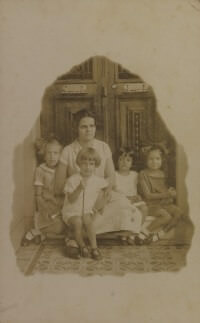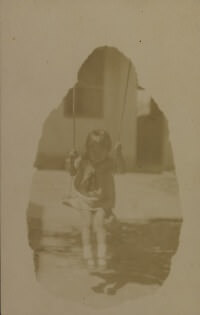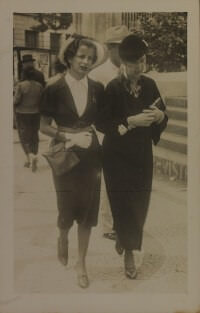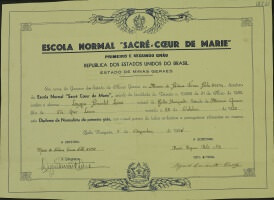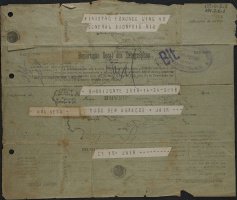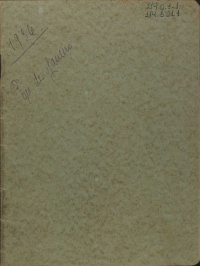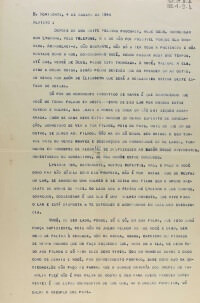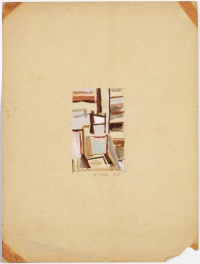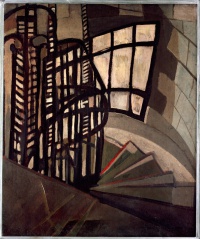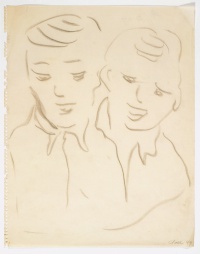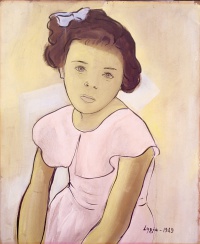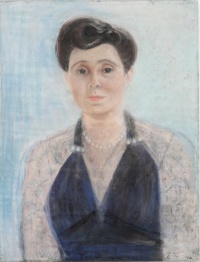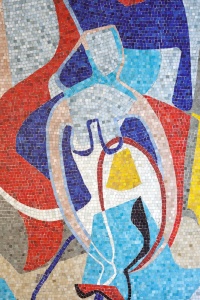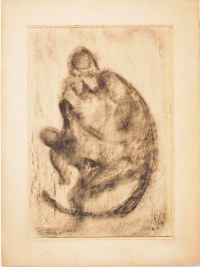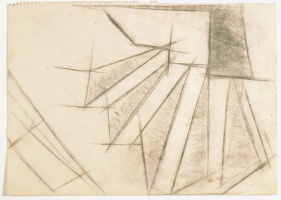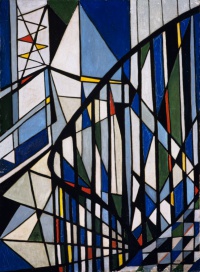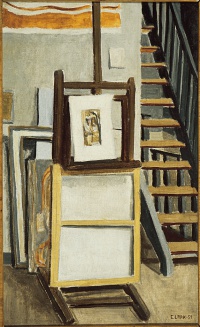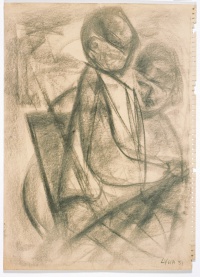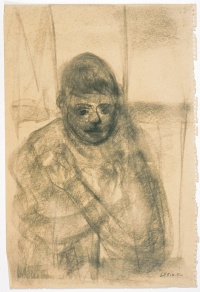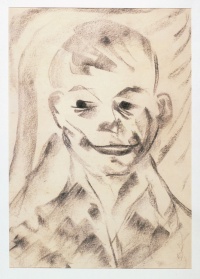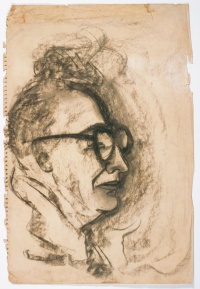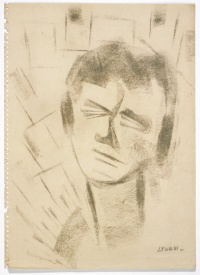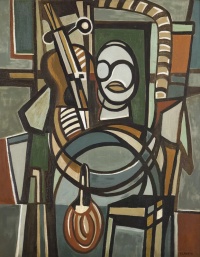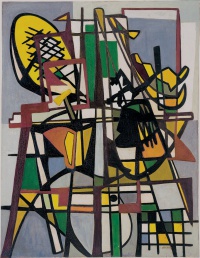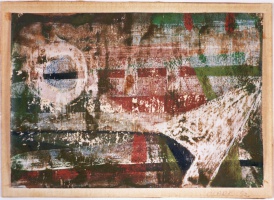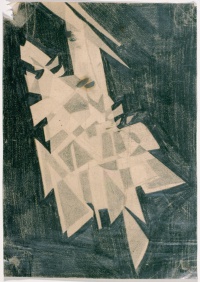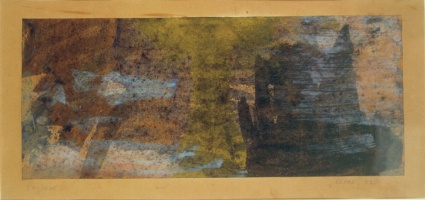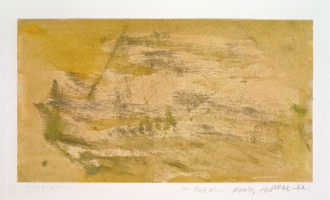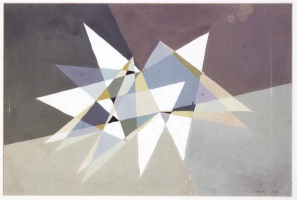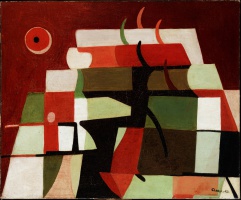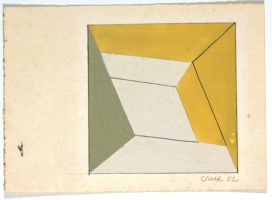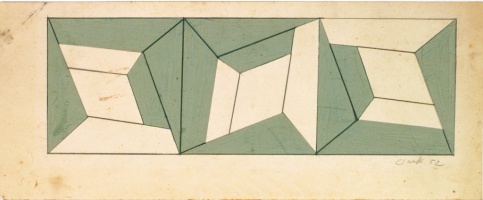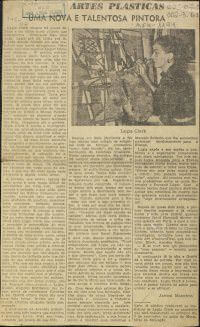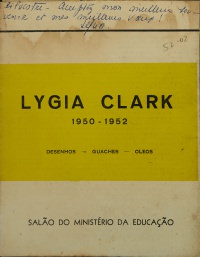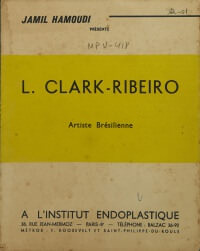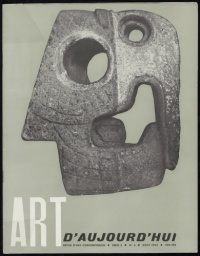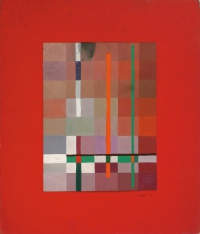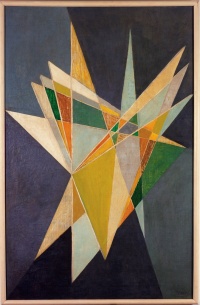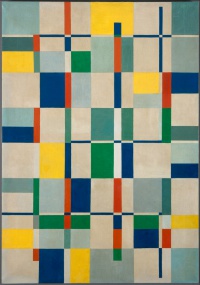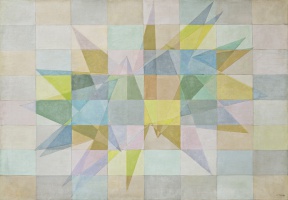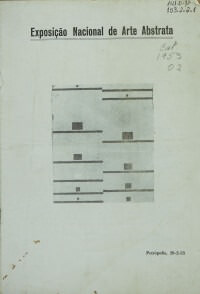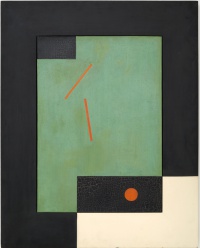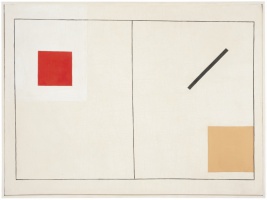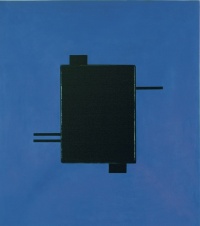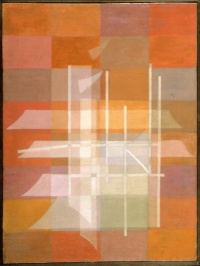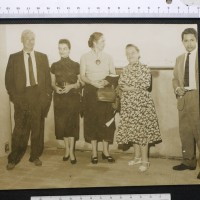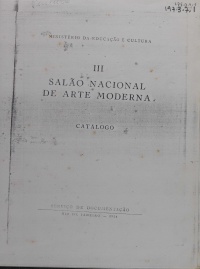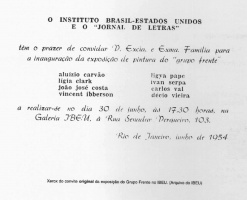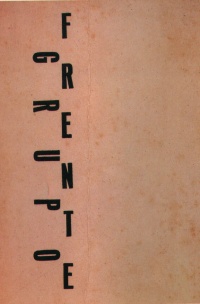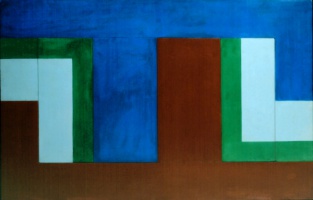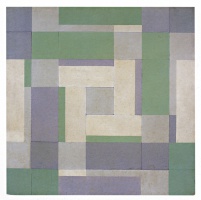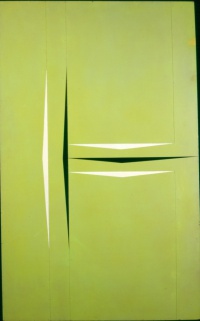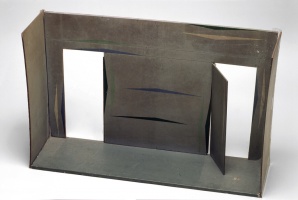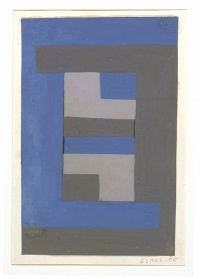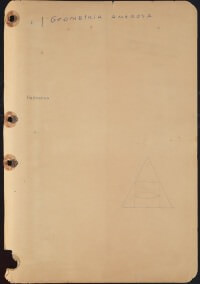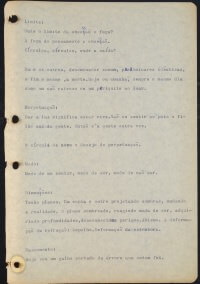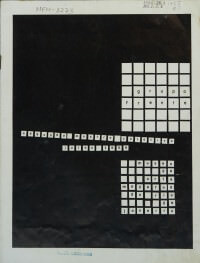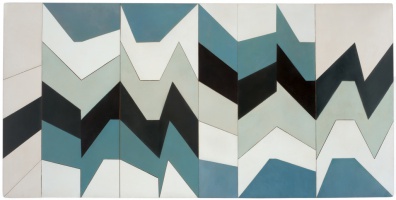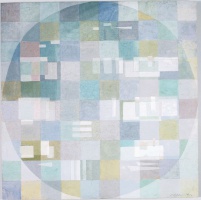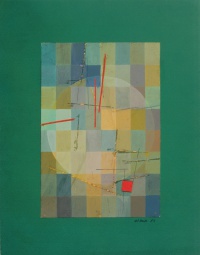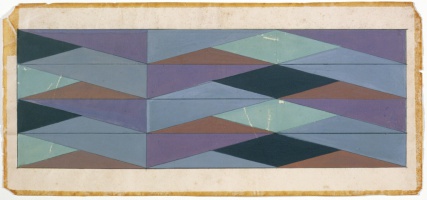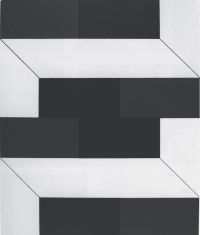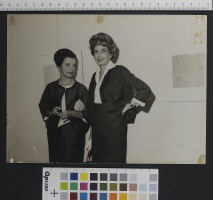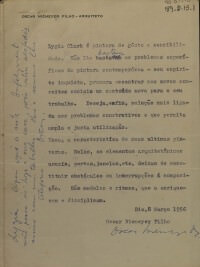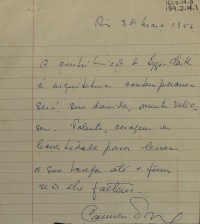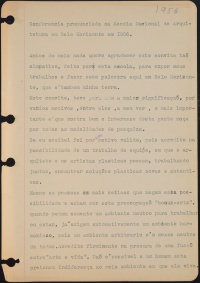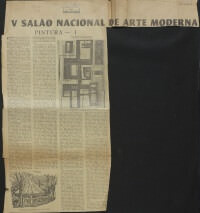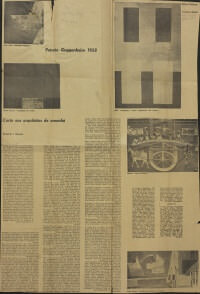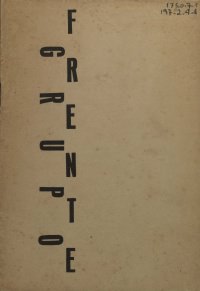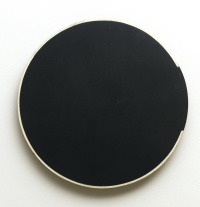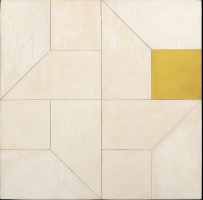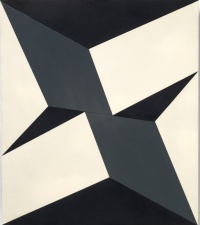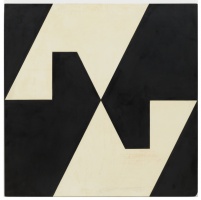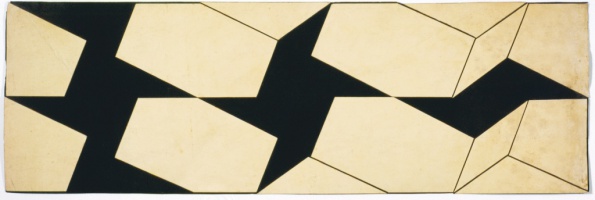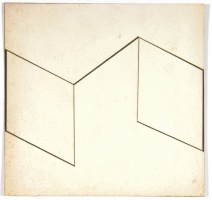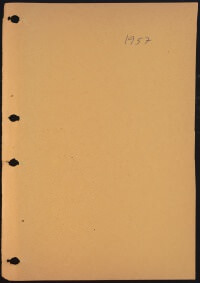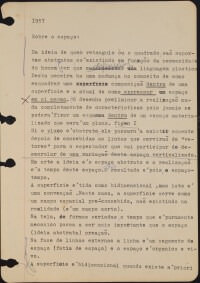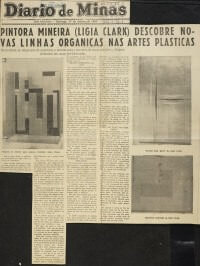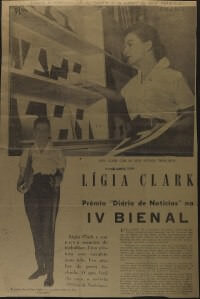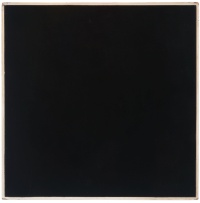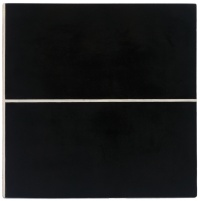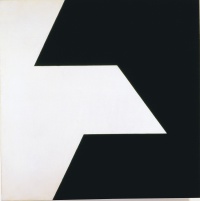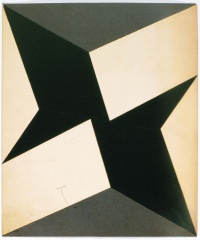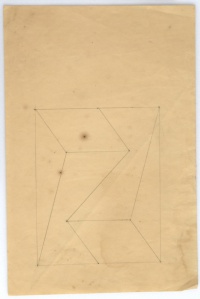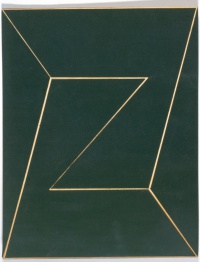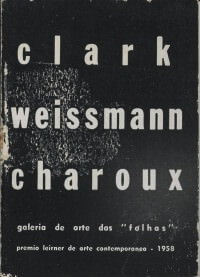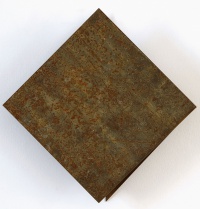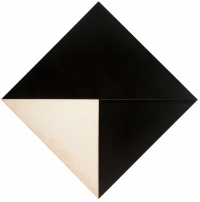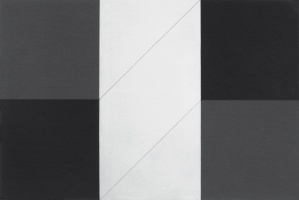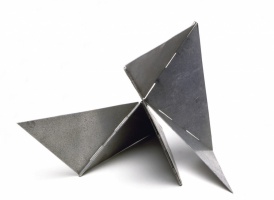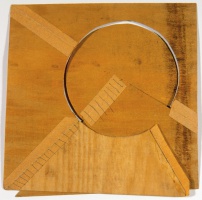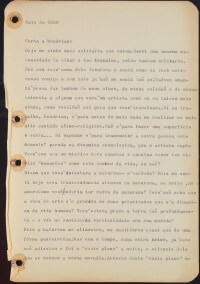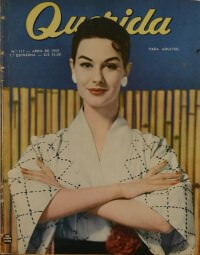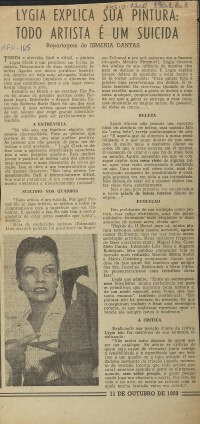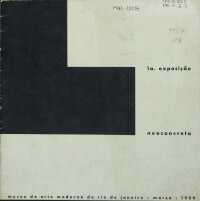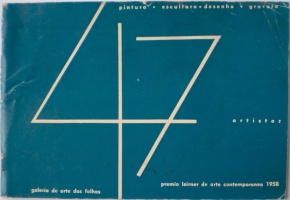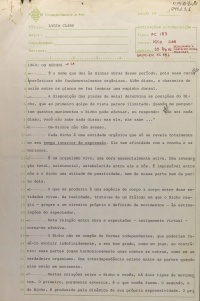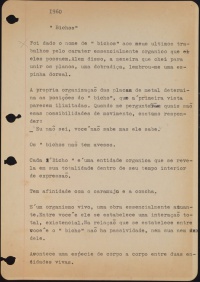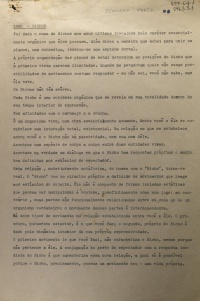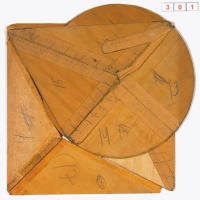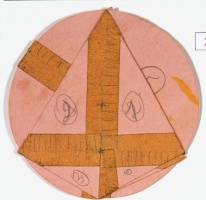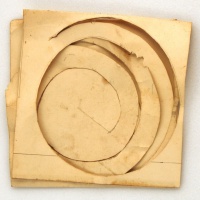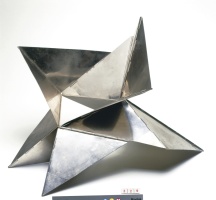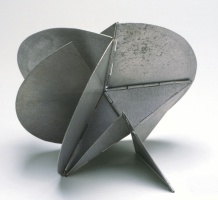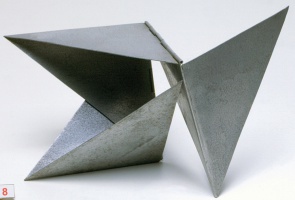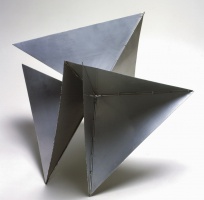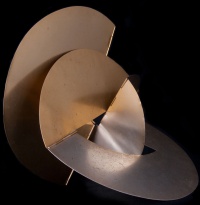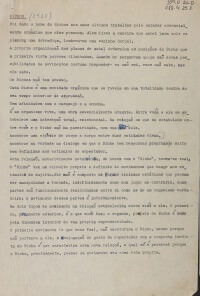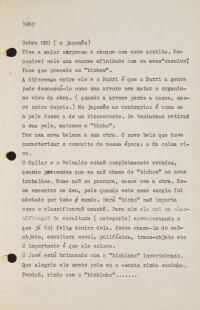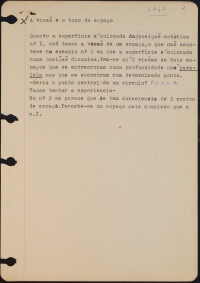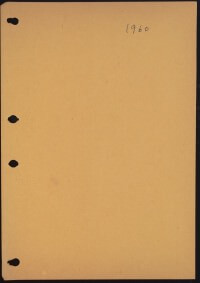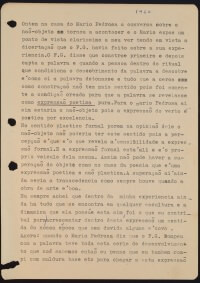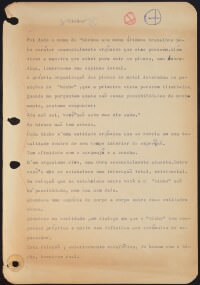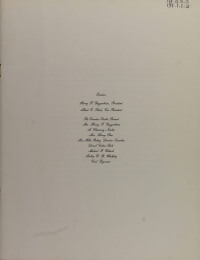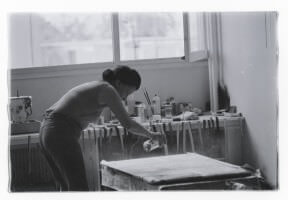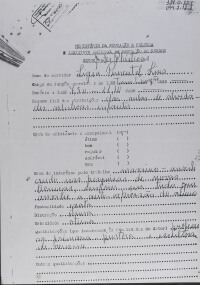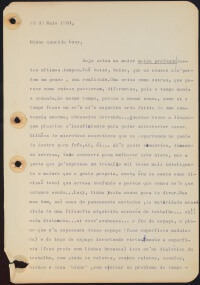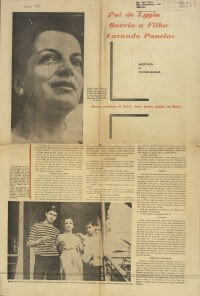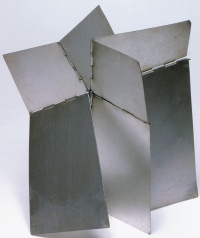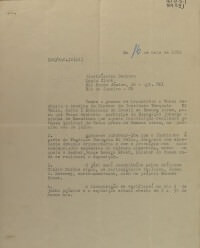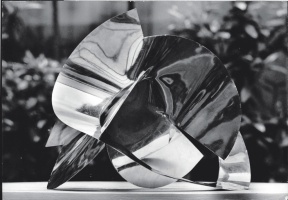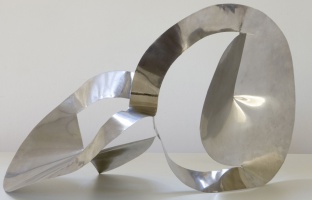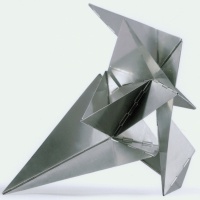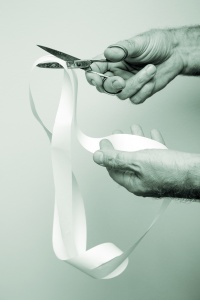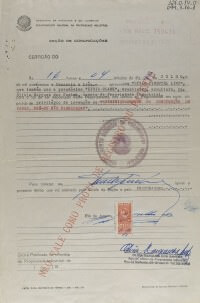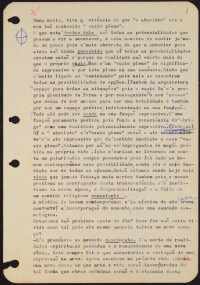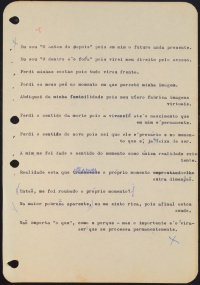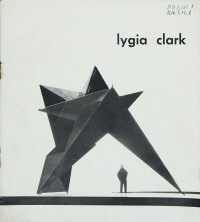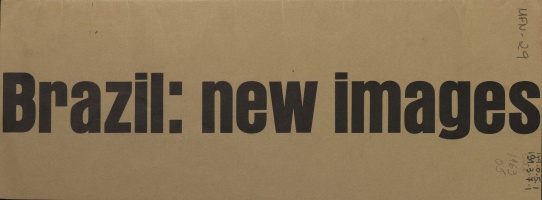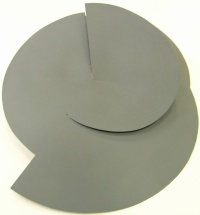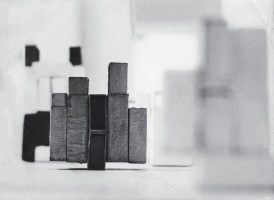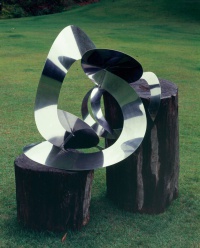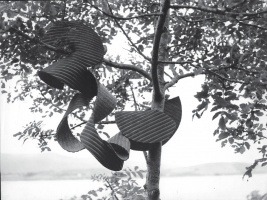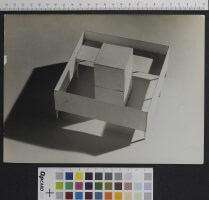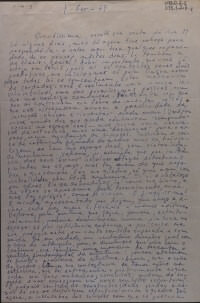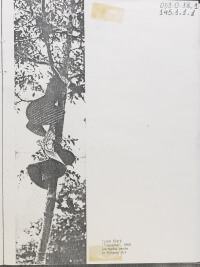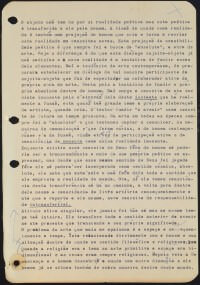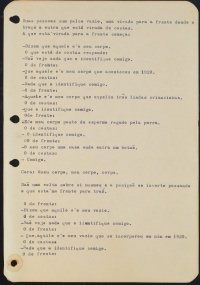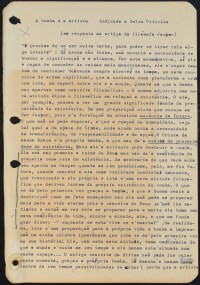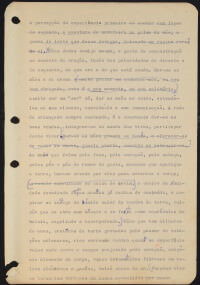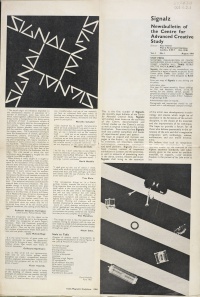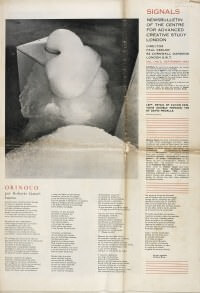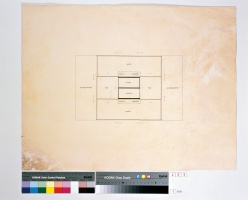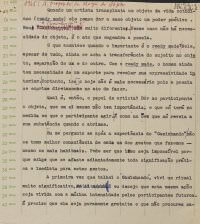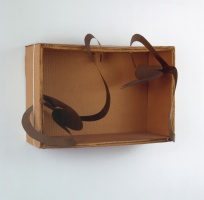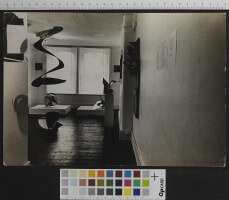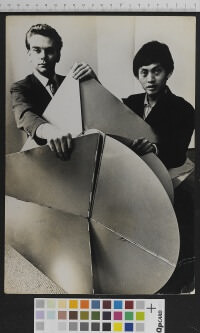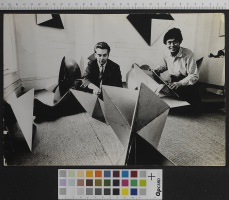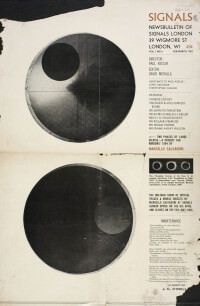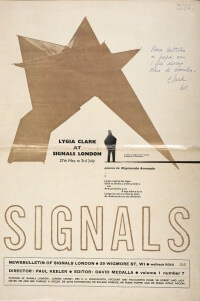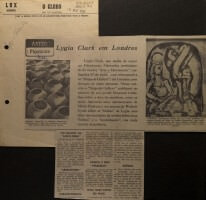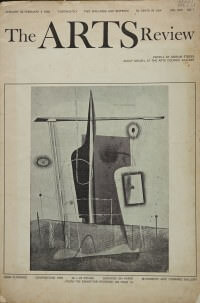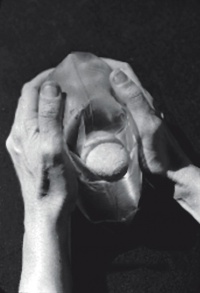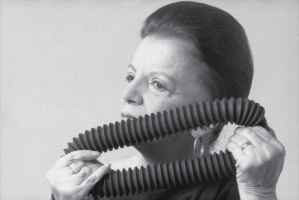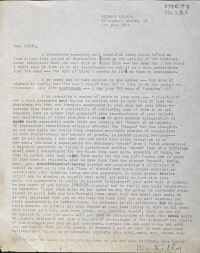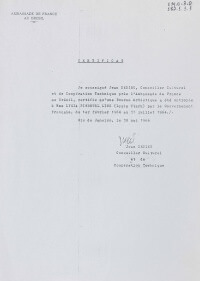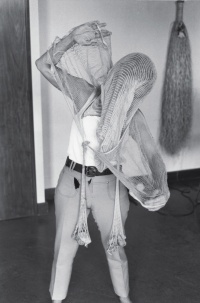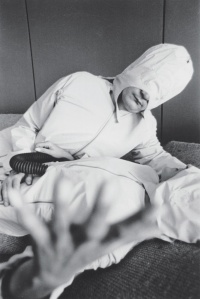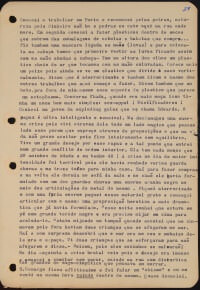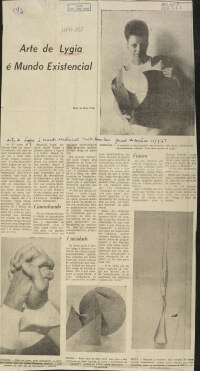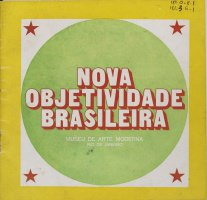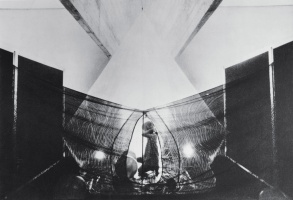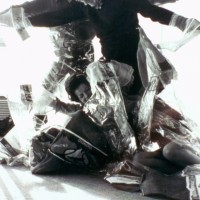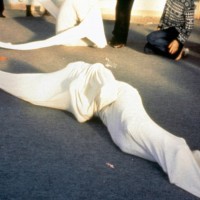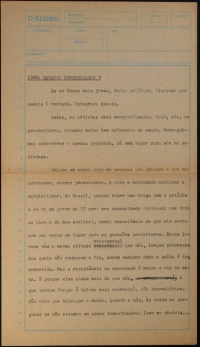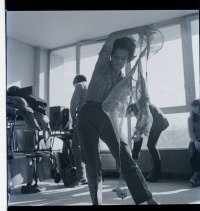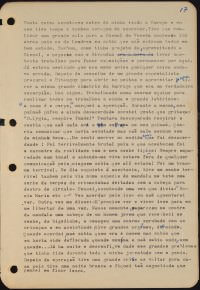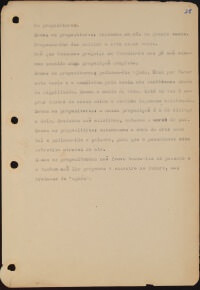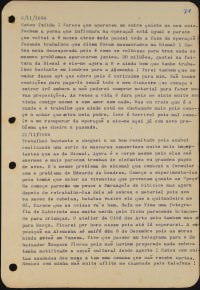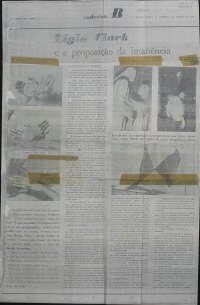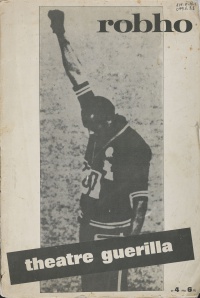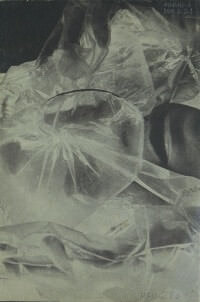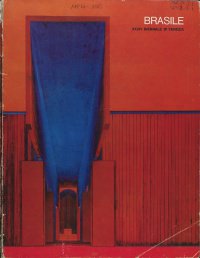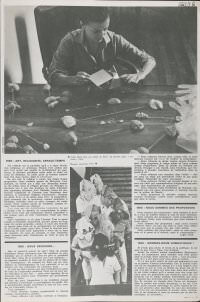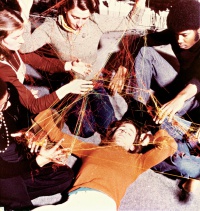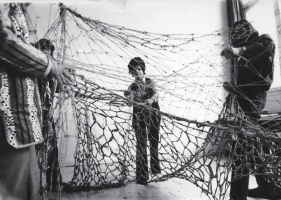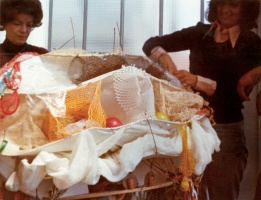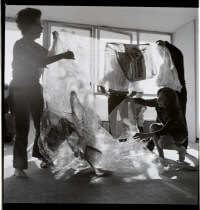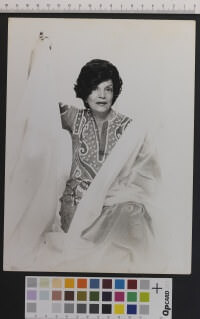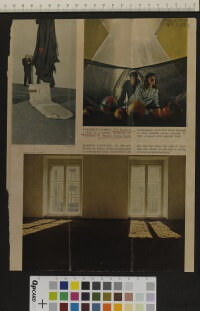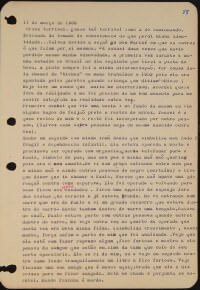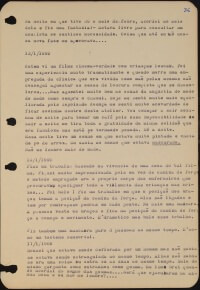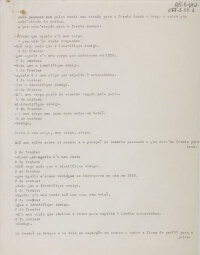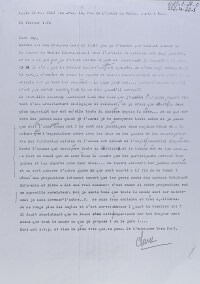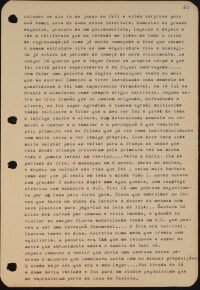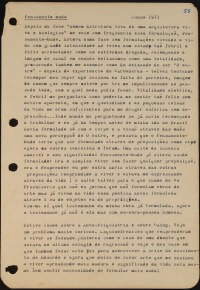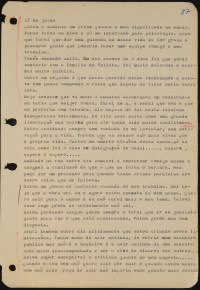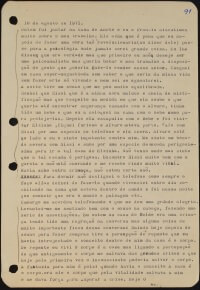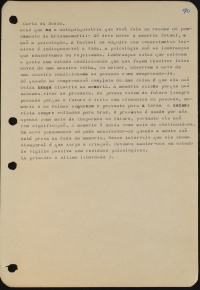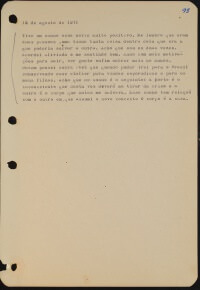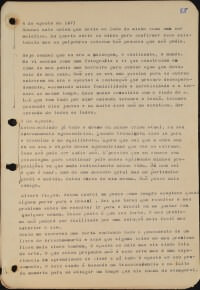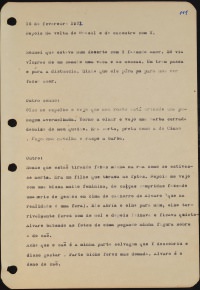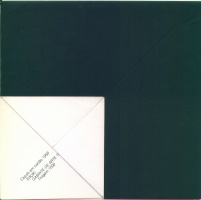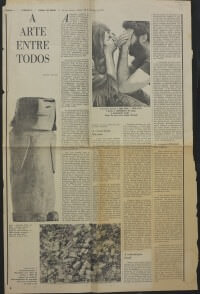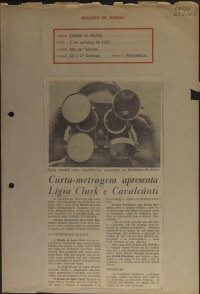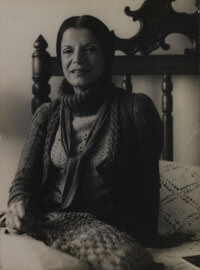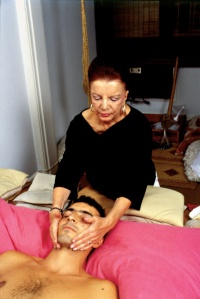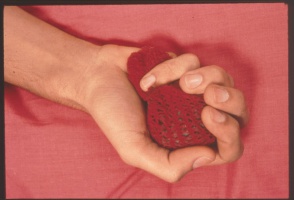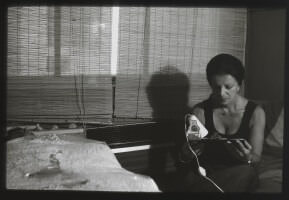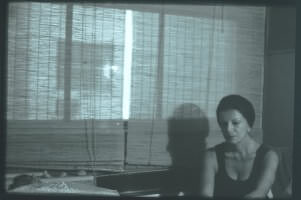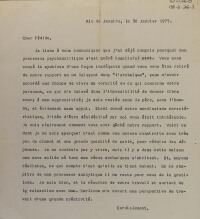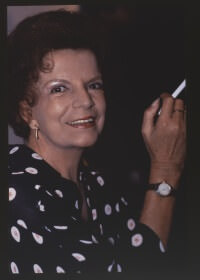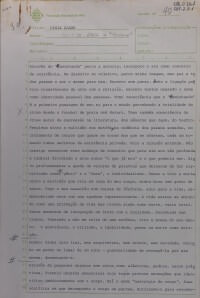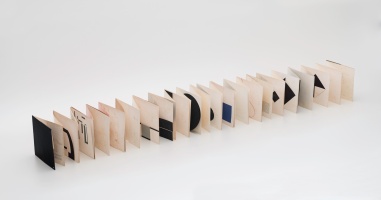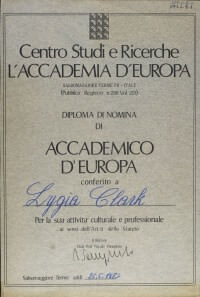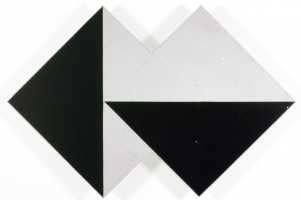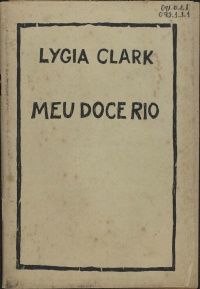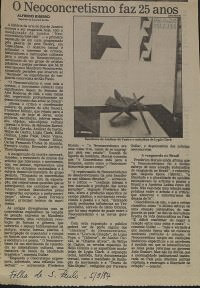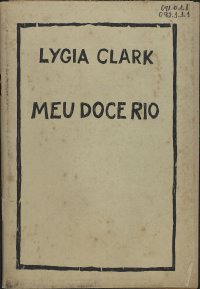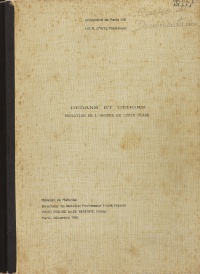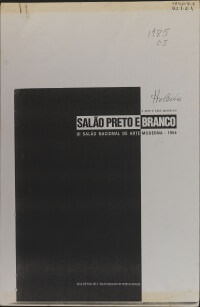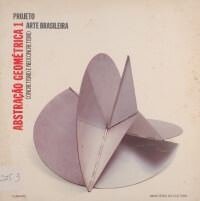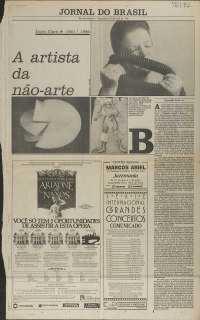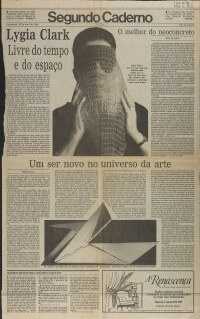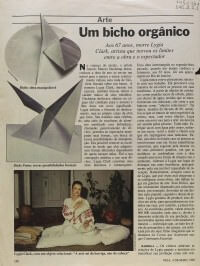Lygia Clark
Timeline
1920-1947
Lygia Pimentel Lins was born on 23 October 1920 in Belo Horizonte (Minas Gerais, Brazil). At the age of 18 she married Aluízio Clark Ribeiro, a mining engineer. The couple moved to Rio de Janeiro and a short time afterwards their Elisabeth was born (1941). Their sons Álvaro were born in 1943 and Eduardo in 1945.
1948-1949
By 1947 and 48 she began art studies with Burle Marx (1909-1994) and Zélia Ferreira Salgado (1904-2009), attending the workshops that Burle Marx organized in his apartment in Leme with Zélia, Mario Pedrosa among others. During this period, he produces drawings and compositions on paper and oil.
1950-1951
In February 1950, on the advice of friends and with the help of her husband, she traveled to Paris to study painting, accompanied by her three children. She spent a good deal of time at Arpad Szene’s studio, where she did her first oil paintings. Later on she studied with Dobrinsky and Léger and produced a substantial series of drawings around the motif of the staircase. At that time she also did a number of charcoal portraits of her children.
World
Creation of the first atomic power plant in the United States.
Under the impact of the Korean War, a military agreement is signed between Brazil and the USA.
World Art
Retrospective show by De Stijl in Amsterdam.
Foundation of Atelier d’Art Abstrait by Jean Dewasne and Edgar Pillet, where Dégand holds a series of lectures.
Arthur Luiz Piza studies with Friedlander, Geraldo de Barros with Hayter, and Mavignier at the Academie de la Grande Chaumière.
Geraldo de Barros begins his studies in graphic arts with Otl Aicher at the School of Ulm, in Germany.
Arquitetura
NO BRASIL
Niemeyer projeta a sua residência na Estrada das Canoas.
1952
In her second year in Paris, by which she had already decided to return to Brazil, she met Jamil Hamoundi, who suggested that she showed her work at the Institut Endoplastique in June and July. After the exhibition closed, she went back to Rio. The following November the show was taken to the Sala do Ministério da Educação in Rio de Janeiro; it included four drawings done in Brazil before the European trip, as well as other works – oils, drawings and gouaches – done in Paris.
Fatos Históricos
IN BRAZIL
Creation of the National Economic Development Bank (BNDE).
Creation of the National Conference of Bishops of Brazil (CNBB).
Start of the campaign Oil is ours.
First number of Manchete magazine.
Creation of the Museum of Images of the Unconscious at the Psychiatric Hospital D. Pedro II by Dr. Nise da Silveira.
WORLD
Under the impact of the Korean War, a military agreement is signed between Brazil and the USA.
Foundation of the Argentina's Modern Artists Group with abstract artists through the action of the critic Aldo Pellegrini.
Kosice makes articulated sculptures without a base.
In Venezuela, the project to integrate the arts in the University City of Caracas begins, designed and designed by Carlos Raúl Villanueva. Arp, Miguel Arroyo, Alexander Calder, Wifredo Lam, Alejandro Otero, Jesús Rafael Soto, Léger, Pevsner, Vasarely, among others, participate.
First issue of Integral magazine, dedicated to architecture and the integration of the arts.
In Santiago, the first exhibition of abstract art is held: Exhibition of Argentine concrete artists.
Artes Plásticas
Maria Leontina studies with Friedlaender as a French government scholarship holder.
Dacosta is also in Paris.
Ivan Serpa exhibits at the Venice Biennale. Mary Vieira establishes herself in Europe.
Franz Weissmann, influenced by Max Bill's Tripartite Unit, executes a series of sculptures that are characterized by cutouts and folds in the square.
Ivan Serpa starts the free workshop and the children's workshop for MAM-RJ courses. Later, he started his group of adult students, from which some of the members of Grupo Frente would leave.
Geraldo de Barros exhibits at MAM-SP.
Grupo Ruptura exhibition and manifesto at MAM-SP (Cordeiro, Sacilotto, Geraldo de Barros, Charoux, Féjer, Wladyslaw, Haar).
Literatura
Publication of the first issue of the magazine Noigandres, by the poets Décio Pignatari, Haroldo and Augusto de Campos who, in contact with Waldemar Cordeiro, will become part of the concrete group from São Paulo.
1953
She won the Prêmio SAPS at the III Salão de naturezas mortas, a cultural event organized by the Associação Brasileira de Imprensa. She also won the Prêmio de la Prefeitura Municipal de Petrópolis at the Exposição nacional de arte abstrata with three Composições done in 1953. The members of the jury for the competition were Niomar Muniz Sdré, Mário Pedrosa and Flávio Aquino. In October she took part in the II Bienal do Museu de Arte Moderna (MAM) in São Paulo, with three Composições done in the same year.
Fatos Históricos
IN BRAZIL
Vargas carries out ministerial reform, choosing João Goulart as Minister of Labor, Tancredo Neves for Justice and Oswaldo Aranha for Finance. Creation of a new ministry, Public Health, unrelated to Education, with Miguel Couto Filho as prime minister of the portfolio. // Sanctioned the law that creates Petrobras and makes oil extraction a state monopoly.
Creation of TV Record, in São Paulo.
I National Exhibition of Abstract Art, at the Hotel Quitandinha, attended by Abraham Palatnik, Aluísio Carvão, Antonio Maluf, Décio Vieira, Ivan Serpa, Lygia Clark, Lygia Pape, Anna Bella Geiger, Antonio Bandeira, Zélia Salgado, among others. The jury composed by Flávio de Aquino, Mário Pedrosa and Niomar Muniz Sodré awarded the MAM-RJ prizes to Décio Vieira and the Municipality of Petrópolis to Lygia Clark. The 2nd São Paulo Biennial takes place. Works by artists such as Picasso, Calder, Mondrian, Paul Klee, Morandi, Henry Moore, among others, were presented. Lygia Clark participates in the Bienal with three compositions created that same year.
IN WORLD
End of the Korean War.
Exhibition of abstract Argentine artists presented in August at MAM-SP goes to the Stedelijk Museum, in Amsterdam. Soto, based in Paris, directs his work for the investigation of optical-kinetic reliefs.
Artes Plásticas
Max Bill's conference at MAM-RJ: The architect, architecture and society. Bill visits Serpa's studio; makes severe criticisms of Brazilian architecture, battered by Lúcio Costa. Amilcar de Castro, in reaction to the conference, approaches Ferreira Gullar and makes his first constructive sculptures. He also started his career as a designer in magazines. Bill will hold the same conference at FAU-USP.
Conferences by Romero Brest and Maldonado at MAM-RJ.
Aldo Pellegrini organizes the Exhibition of the Group of Modern Artists in Argentina at MAM-RJ in which Tomás Maldonado, Lidy Prati, Alfredo Hlito, among others participate. Presented by Romero Brest, it has a great impact on the abstract group in Rio.
Lygia Clark approaches Serpa. She receives the SAPS Award at the III Salon of Still Life.
Foundation of Petit Galerie by Franco Terranova.
Alexandre Wollner and Geraldo de Barros win the prize for the poster for the city's 4th Centenary.
Mira Schendel moves to São Paulo.
Arquitetura
Reidy starts the project for the MAM-RJ headquarters at the Praia de Santa Luzia landfill.
Cinema
The film O Cangaceiro, directed by Lima Barreto and produced by Vera Cruz, receives a special award at the Cannes International Film Festival.
1954
On 30 June the Ist Exposição do Grupo Frente opened at the IBEU – Instituto Brasil-Estados Unidos – in Copacabana. The group was formed by artists from Rio de Janeiro who were part of the Constructivism school, among them Aluísio Carvão, Lygia Clark, João José, Silva Costa, Vincent Ibberson, Lygia Pape, Ivan Serpa, Décio Vieira and Carlos Val. Lygia Clark was chosen to represent Brazil at the Venice Biennale with Ivan Serpa and other artists. The selection was made by Mário Pedrosa, W. Pfeiffer and Bento. Clark exhibited works at the III Salão nacional de arte moderna, organized by the Ministério da Educação e Cultura.
Fatos Históricos
IN BRAZIL
Launch of the Manifesto of the Colonels, in reaction to the proposal for a salary increase sent by Minister João Goulart. This is dismissed shortly thereafter to avoid worsening the political situation.
Carlos Lacerda suffers an attack in Rio de Janeiro and blames the federal government for the episode. Investigations point to Gregório Fortunato, Vargas' head of personal guard, as the mastermind behind the attack.
Suicide of Getúlio Vargas on August 24.
Café Filho takes over the presidency.
Opening of Ibirapuera Park, a project by Oscar Niemeyer.
Geraldo de Barros founds Unilabor, aiming at the industrialization of furniture in a work cooperative system.
IN WOLRD
Algeria's War of Liberation begins.
In Buenos Aires, conference and exhibition of Arte Madí at Casa del Escritor. In June, the publication of the last issue of Madí magazine. The I Salon de la Sculpture Abstraite is held at Galerie Denise René. The Brazilian representation for the Bienal is chosen by Mário Pedrosa. Among the participants, Lygia Clark, Samson Flexor, Alfredo Volpi and Ivan Serpa. Beginning of regular courses at the Escola Superior da Forma, in Ulm, Germany. Maldonado settles in Germany as a teacher at the School, where he teaches until 1967.
Artes Plásticas
Exhibited at MAM-RJ is the cubism exhibition shown at the II São Paulo Biennial, which includes: Braque, Duchamp, Delaunay, Gleizes, Gris, Léger, Lhote, Picabia, Picasso and Brancusi, among others.
Hélio and César Oiticica study with Serpa at MAM-RJ.
Salão Paulista de Arte Moderna: Leontina receives the gold medal, Weissmann the First Sculpture Award and Waldemar Cordeiro, the Acquisition Award.
Willys de Castro and Hércules Barsotti found the Graphic Design Studio.
Barsotti carries out his first constructive works.
Arquitetura
Opening of Ibirapuera Park, a project by Oscar Niemeyer. First issue of the magazine Forma.Niemeyer founds the magazine Module.
Literatura
Opening of Ibirapuera Park, a project by Oscar Niemeyer. First issue of the magazine Forma.Niemeyer founds the magazine Module.
1955
Grupo Frente exhibits again at MAM in Rio de Janeiro. Lygia Clark presents, in addition to a selection of Modulated Surfaces, studies that she calls Loving Geometry and Maquette for interior (I, II and III). The artist's investigations arouse the interest of some architects, such as Niemeyer, with whom she will collaborate in the design of a house in Belo Horizonte. She also participates in the III MAM Biennial of São Paulo, with the Modulated Surface (n ° 1, 2, 3, 4 and 5) and at a collective exhibition of Brazilian artists in Paris, with two compositions from that same year.
Fatos Históricos
IN BRAZIL
Inauguration of the Paulo Afonso Hydroelectric Plant, on the São Francisco River, a landmark in national engineering.
Creation of the Higher Institute of Brazilian Studies (ISEB), with the objective of developing teaching and research activities aimed at carrying out development projects. Juscelino Kubitschek is elected president. Café Filho leaves the presidency of the Republic, which is assumed by Carlos Luz, president of the Chamber of Deputies. A military movement of 11 November is launched, led by General Henrique Teixeira Lott, Minister of War until the previous day, aiming to stop a conspiracy to prevent the inauguration of the elected president. The move causes Carlos Luz, incumbent president, and Café Filho, a graduate, to be impeded, and swears in the Senate vice president, Nereu Ramos, as president. Ramos decrees a state of siege, which will remain in effect until Kubitschek takes office.
3rd São Paulo Biennial.
Fernand Léger, presented in a special room, received the Grand Prize, and Alberto Magnelli, the Painting Prize. Among Brazilians, the presence of geometric abstraction is still striking. Milton Dacosta receives the Painting Award and Wollner, the Poster Award.
Creation, in Rio de Janeiro, of Oca, a modern furniture store, by architect Sérgio Rodrigues.
IN WORLD
At the height of the cold war, the Vietnam War begins, officially fought between North Vietnam and the government of South Vietnam. The North Vietnamese army was supported by the Soviet Union, China and other Communist allies, while the South Vietnamese they were supported by the United States, South Korea, Australia, Thailand, and other anti-communist nations around the world.
First edition of Documenta de Kassel.
Vasarely publishes his Yellow Manifesto on the occasion of the exhibition Le Mouvement, organized by Pontus Hulten at Galerie Denise René, marking the beginning of Cinetismo.
Duchamp's Machine Optique is exhibited alongside works by Agam, Soto, Calder, Vasarely, Tinguely, among others. In this show are the roots of the groups Nouvelles Tendances and Groupe de Recherche d’Art Visuel. Carlos Cruz-Diez travels to Spain, visits Soto in Paris and is interested in Cinetismo. Official opening of the Escola Superior da Forma.
Artes Plásticas
Exhibition at MAM-RJ of Groupe Espace, led by André Bloc. Participating: Arp, Bloc, Sonia Delaunay, Vasarely, Cícero Dias, among others. Presentation by Mário Pedrosa. Organization of the Galerie Denise René.
Amilcar de Castro replaces wood with iron in his sculptures.
Rubem Valentim begins to take an interest in the signs of candomblé, which will eventually become part of his work.
Literatura
Lançamento do segundo número da revista Noigandres.
Arquitetura
Niemeyer founds the magazine Módulo.
Cinema
Rio 40 Graus, a film by Nelson Pereira dos Santos, with a realistic tendency, foreshadows Cinema Novo.
1956
At a conference at the Belo Horizonte School of Architecture, she defends a fusion between art and life and talk about the organic line as a tool for architects and artists, together, rethink living spaces. In December, the 1st National Exhibition of Concrete Art is inaugurated in São Paulo, which brings together artists from São Paulo and Rio de Janeiro, including Lygia Clark. The artist participates in the V Salon of Modern Art, with three modulated surfaces. The Contemporary Brazilian Painting exhibition, held at the Uruguayan-Brazilian Institute of Culture, includes two compositions by the artist.
Fatos Históricos
IN WORLD
February, 24th: the 20th Congress of the Communist Party of the Union of Soviet Socialist Republics (USSR) takes place, which initiates the destanilization.March: France recognizes the independence of Morocco and Tunisia.April: French troops parade for the last time on the streets of Saigon, Vietnam.November, 1st: Hungary proclaims its neutrality and denounces the Warsaw Pact. The USSR reacts by occupying Budapest. The occupation generates protests around the world. Jean-Paul Sartre withdraws his support for the French Communist Party.July: “Suez crisis”. Egypt nationalizes the Suez Canal. Israel occupies the Sinai desert at the end of October, and then France and England are bombing Egyptian airports. On November 5, French and English troops occupied Port-Said and the north of the Canal. Egypt's resistance, supported by the USSR, American non-intervention, and the disapproval of the United Nations (UN) force the Franco-British withdrawal from the region. France tries to insist, but the British withdrawal makes operations impossible. Nasser, in power since 1954, is again proclaimed president of Egypt.In Britain, the first nuclear power plant is built.Established the number of chromosomes in the human body.Actress Grace Kelly marries Prince Rainier III of Monaco.
IN BRAZIL
January, 31: President Juscelino Kubitschek (JK) implements the 50-year goal program in 5 years. February, 29: the Jacareanga Rebellion, in Goiás, is defeated, when some Air Force officers tried to overthrow the government. JK. September, 19: Law No. 2874 is signed, which regulates the transfer of the capital to Brasília, and creates the Companhia Urbanizadora da Nova Capital (Novacap). November, 21: General Juarez Távora is punished with house arrest for 48 hours for public criticism of the president. December, 14: Brazil buys a British aircraft carrier with technology outdated from World War II - Minas Gerais - in response to the identical acquisition carried out by the Argentine Navy. The Automobile Industry Executive Group (GEIA) is created. Willys and Vemag (Auto-Union) launch Rural and Vemaguette, Romi-Isetta was manufactured in Brazil since 1955. Volkswagen do Brasil is founded; and Mercedes Benz starts its production of trucks, buses, chassis and engines.
Ademar Ferreira da Silva becomes two-time triple jump Olympic champion in Melbourne, Australia, breaking his own record, set in 1952 at the Helsinki Games, Sweden.
Álvaro Moreyra and Jorge Amado re-launch Para Todos, “biweekly Brazilian culture". At Para Todos, which had Nélson Werneck Sodré as editor-in-chief, and James Amado as secretary, visual artists acted as interviewing reporters and art critics. The work Ideology and national development, by Álvaro Vieira Pinto, is launched. The publication transcribes the inaugural lecture of the Instituto Superior de Estudos Brasileiros, given by the author on May 14, 1956, in the auditorium of the MEC (Ministry of Education and Culture), in Rio de Janeiro, Brazil. The lecture was attended by then President Juscelino Kubitschek and faculty of the Institute. Psychiatrist Nise da Silveira, a pioneer in the use of art in the therapy of psychotic patients, opens Casa das Palmeiras - a center dedicated to the application of her therapeutic techniques, in the neighborhood of Botafogo, in Rio.
Artes Plásticas
In March, Grupo Frente held an exhibition in Itatiaia, RJ, and in June at Companhia Siderúrgica Nacional (CSN), in Volta Redonda, sponsored by the Museum of Modern Art in Rio de Janeiro (MAM-RJ).
At MAM-RJ, a retrospective of Goeldi and a debate on Brazilian prints with Flexa Ribeiro, Poty, Jorge Amado, Quirino Campofiorito, Bruno Giorgi and Lívio Abramo are held in October; and in December an exhibition on the Escola Superior da Forma, founded in Germany by Max Bill. The panels Guerra e Paz, painted by Portinari for the UN building in New York, are exhibited at the Teatro Municipal in Rio.
Literatura
Grande sertão: veredas, by Guimarães Rosa, Vila dos Confins, by Mário Palmério and The scheduled meeting, by Fernando Sabino. Third issue of Noigandres magazine.
Arquitetura
The Brasília Pilot Plan was chosen by tender. After several discussions and debates, the jury decides on Lúcio Costa's project.In the future Federal District, Catetinho is built, the temporary residence of President JK, which also hosted Oscar Niemeyer.
Theatre
In Rio, Orfeu da Conceição, by Vinícius de Morais, is staged, with music by Tom Jobim and Vinícius, and sceneries by Oscar Niemeyer. In São Paulo, the Arena Group stages Ratos e Homens, by Steinbeck, directed by Augusto Boal.
1957
Segue expondo ativamente nas principais mostras do Rio de Janeiro e São Paulo. Expõe no VI Salão Nacional de Arte Moderna na IV Bienal de São Paulo, onde apresenta 3 de seus Planos em Superfície Modulada e recebe o prêmio Diário de Notícias. A I Exposição Nacional de Arte Concreta, realizada no Museu de Arte Moderna de São Paulo vem para o Rio de Janeiro no MEC. A imprensa destaca a arte de Lygia Clark como prova viva da vitalidade da arte concreta no país.
Fatos Históricos
IN BRAZIL
January: A detachment from the Brazilian Army leaves for the Suez Canal to join the UN Peacekeeping Force. January, 21: Brazil allows the installation of a North American rocket tracking base in Fernando de Noronha. February: construction of Brasília begins. July, 22: general strike of metallurgists in Rio. August, 22: presentation of the voting project for illiterates, authored by General Henrique Lott. October, 15: general strike in São Paulo. 400,000 workers stop, demanding a 25% wage increase. Willys launches the Jeep; Volkswagen launches the Kombi, and Vemag launches the Candango.
Created in Rio, with the support of UNESCO, the UN agency for Education, Science and Culture, the Latin American Center for Research in Social Sciences. The Concretist Manifesto is published. Ferreira Gullar breaks with the group of concrete poets from São Paulo.
IN WOLRD
March 25: the Treaty of Rome is signed, creating the European Economic Community (European Common Market) and the European Atomic Energy Community (Euratom). September, 22: François Pope Doc Duvalier is elected president of Haiti. In the following year Papa Doc created his private militia, the tonton-macoutes, base of his personal power and in 1964 he imposed a new constitution, conferring the titles of Salvador da Pátria and Presidente Vitalício. October: the USSR takes the lead in the space race, launching the first artificial satellite - Sputinik I. In November it launches Sputinik II, taking the dog Laika on board. In Africa, Ghana becomes independent. The International Chemistry Union takes carbon as the basis of atomic masses. The first bone marrow grafts are successfully performed. The first stereophonic records start to be commercialized in the USA; Christian Dior dies.
Asger Jorn and Pinot-Gallizio found Laboratorio Alba, in Italy. In West Germany, Otto Piene, Heinz Mack and Günther Uecker found the Zero Group. Wallace Berman is arrested on charges of obscenity at his first exhibition at the newly opened Ferus Gallery. Sculptor Brancusi dies. // Albert Camus wins the Nobel Prize for Literature. Reg Smythe launches Andy Capp; and Mel Lazarus launches Miss Peach. // Samuel Becket launches Endgame. // In cinema, the first in the long series of horror films produced by Hammer Films in England, The Curse of Frankenstein; The seventh seal, by Ingmar Bergman, shares the Palme d'Or in Cannes with the Polish film Kanal. Fellini wins the Oscar for best foreign film with The road to life.
Artes Plásticas
The I National Exhibition of Concrete Art is brought to MAM-RJ. The IV São Paulo Biennial takes place, and Lygia Clark wins the Acquisition Award.
Literatura
The cedar madonna, by Antônio Callado.
Cinema
Rio zona norte, by Nelson Pereira dos Santos.
Teatro
In Rio, The lesson, by Ionesco, with Luís de Lima, Glauce Rocha and Aurora Aboim; and Perdoa-me pr me traíres, by Nélson Rodrigues, with the author and Gláucio Gil (this was the only performance of Nélson Rodrigues as an actor). In São Paulo the Arena Group premieres the play Only the Pharaoh has a soul, by Silveira Sampaio, with Oduvaldo Viana Filho. In Porto Alegre, at the University Theater of the State Student Union (UEE), The Glass Menagerie, by Tennesse Williams, with Antônio Abujamra and Lilian Lemmertz.
Music
Sinfony nº 11, Dimitri Chostakovitch; West Side Story Leonard Bernstein; Pli selon pli (1957-62), Pierre Boulez; Cecil Taylor at Newport Jazz Festival; Charles Mingus, LP East Coasting; Max Roach, LP Jazz in 3/4 Time.Jerry Lee Lewis reords Great balls of fire.Maestro Arthuro Toscanini dies. Louis Armstrong performs at the Ibirapuera gym, sharing the stage with Ângela Maria. The show is broadcast on TV Record.
1958
Lygia Clark segue realizando suas experiências em Superfícies Moduladas e Espaços Modulados, e, com Franz Weissmann e Lothar Charoux, expõe na Galeria de Arte das Folhas de São Paulo. Recebe em Nova York o Prêmio Internacional Guggenheim.
Fatos Históricos
IN WORLD
February: the USA creates the National Space Administration Agency (NASA), and manages to launch its first satellite: Explorer I. In March, they launch Vanguard I. The Soviet response comes in May, with Sputinik III.April, 17: the Universal Exhibition of Brussels is inaugurated, with the theme of the atom, represented by the futuristic construction Atomium.May: a revolt by the French military in Algeria causes General De Gaulle to be called to form a new government, initiating the Fifth Republic.July, 7: Alaska, purchased from Russia by the USA in 1867, becomes the 49th American state.August: France proposes to its African colonies the choice between independence or autonomy within the French community. Only Guinea votes for independence.September, 3: the European Court of Human Rights is inaugurated.October 9: Pope Pius XII dies.Egypt forms, with Yemem and Syria, the United Arab Republic (RAU), dismembered in 1961.Great Britain, outside the European Economic Community, forms, with the other non-participating countries, the European Free Trade Alliance (AELC).
Two thousand people attend the vernissage of the exhibition The Void, by Yves Klein, at the Iris Clert Gallery, in Paris, and Jasper Johns makes his first solo show, at the Leo Castelli Gallery, in New York. Miró composes a ceramic mural for the UNESCO building in Paris.
At the Universal Exhibition in Brussels, the Guernica canvas by Pablo Picasso is displayed at the Pavilion of Spain. Published, The Human Condition, by Hannah Arendt; Structural anthropology, by Claude Lévi-Strauss; The individual and the infinite, by Leszek Kolakowski.
IN BRAZIL
January, 25: the first nuclear reactor in Latin America is installed at the University of São Paulo (USP). March, 16: a mission from the International Monetary Fund (IMF) arrives in Rio, to establish the conditions for a loan requested by JK. April: due to the drought that is plaguing the Northeast, the Law on Relief for Flagellates is enacted. Marshal Cândido Mariano da Silva Rondon dies. Maria Esther Bueno conquers, in partnership with Althea Gibson, her first title at Wimbledon. The Palácio da Alvorada is inaugurated in Brasilia. Ford of Brazil is inaugurated. Vemag launches DKW (Das Klein Wunder - 'The Little Wonder'), Belcar.
In Brazil it seems that President Juscelino Kubitscheck's audacious project of developing Brazil “fifty years in five” seemed to become reality.
In 1958, Brazil wins its first World Cup. Bossa Nova appears. The first LP recorded of the new style was Canção do amor muito, with songs by Tom Jobim and Vinícius de Morais, performed by Elizeth Cardoso.
Raimundo Faoro publishes Os Donos do Poder.
Artes Plásticas
Lygia Clark continues performing her experiments Modulated Surfaces and Modulated spaces, and, with Franz Weissmann and Lothar Charoux, she exhibits at the Galeria de Arte das Folhas. Hélio Oiticica paints, with gouache on cardboard, the Metaesquemas series.
Arquitetura
The Seagram Building in New York, designed by Mies van der Rohe and Philip Johnson, is built. The Seagram Building mural was painted by Mark Rothko.
Literatura
Gabriela, clove and cinnamon, by Jorge Amado, sells, in two weeks, 20,000 copies. Translated into English, it is the first Latin American novel to become a best seller in the USA. Fourth issue of Noigandres magazine.
Cinema
The film Jamboree, with Cauby Peixoto, was released in Brazil; under the alias of Ron Coby; singing Toreador.
In the grip of vice, Chabrol's film, formally inaugurates the nouvelle vague, advocated since 1956 by the publication Cahiers du Cinéma. Charles Chaplin films A King in New York, and Hitchcock releases Vertigo ('A body that falls', in Brazil).Mon oncle ('My uncle'), by Jacques Tati, wins the Special Jury Prize at the Festival de Cannes. The success of the film is confirmed in Hollywood, which awarded him the Oscar for best foreign film the following year.
At the Oscars, The Bridge on the River Kwai wins the awards for best film, direction (David Lean) and best actor (Alec Guinness). Fellini again wins the statuette of best foreign film with Nights of Cabiria.
Teatro
In São Paulo the Arena Group stages They don't wear black tie, by Gianfrancesco Guarnieri. In Belém do Pará, at Teatro Escola, the play Morte e vida Severina, by João Cabral de Melo Neto, is staged with Carlos Miranda. In Porto Alegre, Paulo José and Lineu Dias act in Waiting for Godot, directed by Luiz Carlos Maciel.
Ballet
Gilberto Motta produces the Neoconcrete Ballet, created by Lygia Pape from the poem Olho / garlic, by Reinaldo Jardim.
Música
The first LP recorded in the Bossa Nova style was Canção do amor demais, with songs by Tom Jobim and Vinícius de Morais, performed by Elizeth Cardoso. João Gilberto records a 78 rpm, with the song Chega de saudade.
Sequenza I by Luciano Berio; Movements for piano and orchestra (1958-59), by Igor Stravinski; Sur scène (1958-59) for reciter, mime artist, singer and three instrumentalists, by Mauricio Kagel; Transición II (1958-59) for piano, percussion and magnetic tapes, by Mauricio Kagel; Kontakte (1958-60) electronic score for four channels, by Karlheinz Stockhausen; Billie Holiday, LP Lady in Satin; Miles Davis, LP Milestones.
1959
A I Exposição neoconcreta, inaugurada no MAM do Rio de Janeiro, se converte no acontecimento artístico mais importante do ano. Lygia Clark apresenta vinte obras. Os artistas participantes, oriundos do Grupo Frente, assinam um Manifesto Neoconcreto, publicado no Jornal do Brasil, rompendo com o concretismo. Defendem a introdução da expressão na obra de arte, rejeitando o primado da razão sobre a sensibilidade e colocam-se contra a exacerbação racionalista a que os concretistas haviam levado sua obra.
Participam Amílcar de Castro, Ferreira Gullar, Franz Weissman, Lygia Clark, Lygia Pape, Reynaldo Jardim e Theon Spanudis.
Suas pesquisas se voltam para a Linha Orgânica, que aparece na junção de dois planos. As composições em preto e branco que fez entre 52 e 59 que demonstavam a sua presença ou ausência apontam para novas descobertas. Dessas experiências são criados os Casulos feitos de metal, onde o plano ee dobrado e uma nova dualidade aparece na obra de Lygia Clark. Em junho, Lygia Clark participa da exposição Brasilianischer Künstler, na Haus der Kunst de Munique.
Participa da V Bienal do MAM de São Paulo.
Fatos Históricos
IN BRAZIL
May: Fidel Castro visits Brazil. June, 28: in a speech at the Clube Militar, in Rio, Juscelino Kubitschek breaks with the IMF. December, 3: new uprising of Air Force officers, this time in the region of Aragarças, Goiás. December, 10: Jânio Quadros runs for president. December, 12: Marshal Henrique Lott is nominated by the Social Democratic Party (PSD) to run for president. December, 15: the Northeast Development Superintendency (SUDENE) was created, idealized by Celso Furtado, who is named its first superintendent. Cacareco, rhinoceros from the Rio Zoo, loaned in 1958 for the inauguration of the São Paulo Zoo, was the most voted councilor in the city of São Paulo. Cacareco totaled almost 100,000 votes, against 95,000 counted by the most voted party. Dauphine, FNM JK, Fusca and Simca Chambord are launched. Brazil wins the III World Basketball Championship for Men.
In Rio de Janeiro, the Neoconcrete Manifesto is launched. Ferreira Gullar publishes, in the Jornal do Brasil, the Theory of the Non-Object and Reinaldo Jardim publishes the Neoconcrete Prose. // Published in Brazil the works Economic formation of Brazil, by Celso Furtado; Formation of Brazilian literature, by Antônio Cândido; History of Western Literature, by Otto Maria Carpeaux; Vision of paradise, by Sérgio Buarque de Holanda; Order and progress, by Gilberto Freire; The work in the modern world, by Alceu Amoroso Lima and Education and Brazilian reality, by Paulo Freire.
WORLD
The first submarine telephonic cable between the USA and Europe is inaugurated.The Soviet probe Luna II hits the Moon.The dark side of the Moon is photographed by the Soviet probe Luna III.Fidel Castro and his guerrillas seize power in Cuba. The movement overthrew the dictatorship of Fulgêncio Batista.India and China are in conflict over border issues. The lack of Soviet support for Chinese claims, and Mao Zedong's criticisms of Kruschev's trip to the USA, shake Sino-Soviet relations. China begins to radicalize, becoming the third world force.Hiroshima hosts the 5th World Conference against Atomic Weapons.The American submarine George Washington, built in England, is equipped with six Polaris atomic missiles.The Inter-American Development Bank (IDB) is created.Second generation computers, transistorized and with central memory integration are launched.The first kidney transplant in humans is performed by Merril, in the USA. Albert Sabin develops the oral polio vaccine, and the French Taupin and Lejeune publish their work on diseases caused by chromosomal aberrations.
In New York, Allan Kaprow stages 18 Happenings in 6 Parts, and Clement Greenberg organizes Barnett Newman's retrospective.
Artes Plásticas
The 5th São Paulo Biennial is characterized by the new international trend: informalism.
Mário Pedrosa organizes the Extraordinary International Congress of Art Critics, in Brasília, Rio and São Paulo, and presents the retrospective of Milton Dacosta at MAM-RJ.
First National Industrial Design Competition was held at the Institute of Architects of Brazil (IAB), in São Paulo.
Lygia Clark creates the Bichos series, and participates in the exhibition Brasilianischer Künstler, at Haus der Kunst in Munich and at the 5th São Paulo Biennial.
Literatura
Chronicle of the murdered house, by Lúcio Cardoso, Histories nothing exemplary, by Dalton Trevisan.
Book-poem exhibition, at Jornal do Brasil, with works by Lygia Pape, Theon Spanudis, Willys de Castro and Ferreira Gullar.
Comics: Robert Crumb launches Fritz, the cat. The commercial exploitation of the character made the author murder him in 1973.
Jean Michel Charlier, René Goscinny and Albert Uderzo launch the magazine Pilote, where the first stories of Asterix, the Gaul, are published.Literature: The drum, by Günther Grass.The book Lady Lover by Chaterley is released in the USA. In England, where it was written, it was not released until the following year.
Arquitetura
The Guggenheim Museum opens in New York, designed by Frank Lloyd Wright. The architect, considered the first representative of organic architecture, built “from the inside out”, dies in the same year.
Cinema
Marcel Camus films Orfeu do Carnaval, based on the play Orfeu da Conceição, by Vinícius de Morais. With the soundtrack of the play, and scenes recorded at the Rio carnival, he won the Palme d'Or in Cannes, and won the Oscar for best foreign film the following year. The film O Homem do Sputinik, directed by Carlos Manga, marks the debut of Norma Bengell in cinema, and the end of the cycle of chanchadas.
Teatro
Teatro dos Sete shows Mambembe, with Fernando Torres and Grace Moema, and Grupo Arena stages Revolution in South America, by Augusto Boal; and Chapetuba F. C., by Vianinha.
Música
Desafinado, Bossa Nova music-manifesto.Maestro Heitor Villa-Lobos and singer Dolores Duran die.
Cecil Taylor, LP The World of Cecil Taylor; Miles Davis, LP Kind of Blue, including John Coltrane and Bill Evans; Thelonius Monk, LP In Concert: Townhall.
Billie Holiday and Lester Young die.
1960
Ao longo deste ano trabalha como professora de Artes Plásticas no Instituto Nacional de Educação dos Surdos no Rio de Janeiro. Em maio participa, junto com outros 23 artistas, da exposição inaugural da Galeria Bonino, e expõe uma das peças da série Contra-relevo. Em outubro, a artista apresenta, também na Galeria Bonino, sua série Bichos, construções metálicas geométricas que se articulam por meio de dobradiças e requerem a coparticipação do espectador, com os seguintes títulos: Invertebrado, Ponta, Desfolhado, Articulado, Articulado duplo, Metamorfose I, Prisma, Metamorfose II, Vegetal, Constelação, Contrário I, Cidade, Contrário II, Vazado I, Vazado II, Sobre o redondo. A exposição obtém um grande êxito e gera numerosas críticas na imprensa.
Em novembro é realizada a II Exposição Neoconcreta, no Ministério de Educação do Rio de Janeiro.
Em dezembro, Lygia Clark participa da exposição Contribuição da mulher às artes plásticas no país, junto com Tarsila do Amaral, Anita Malfatti, Maria Leontina, Elisa Martins e Tomie Ohtake entre outras.
Fatos Históricos
BRAZIL
February, 20: US President Eisenhower visits Brasilia. In Rio, the National Student Union (UNE) protests against the visit. March: Presidential candidate Jânio Quadros visits Fidel Castro in Cuba. April, 21: the new federal capital, Brasília, is inaugurated. May, 21: the Brazilian ambassador in Washington, Walter Moreira Salles, resumes the dialogue with the IMF, obtaining a loan of US $ 47.700.000 October, 3: Jânio Quadros is elected president of the Republic, with 48% of the votes, defeating Marshal Lott, candidate of the nationalist forces, and Ademar de Barros, former governor of São Paulo. Jânio's runner-up, Milton Campos, is, however, defeated by labor leader João Goulart, political heir to Getúlio Vargas, candidate for runner-up in Henrique Lott. November, 14: the maritime and rail transport sectors trigger the so-called Strike of Parity, where they demand salary parity with the military. The strike only ends, a week later, with military intervention. November, 23: the Parity Law is passed. Simca Presidente and Aero Willys are launched. Volkswagen dominates the market, with 48% of production. Willys holds 26%, Vemag 16%, Simca 9% and FNM only 1%. Éder Jofre wins the world boxing title, in the “bantamweight” category, and maintains it until 1965, when he is defeated by the Japanese Masahiko Harada. According to the 1960 census, Brazil's population was 70,191,370 inhabitants. The city of São Paulo had 3,781,446 inhabitants, and Rio de Janeiro 3,281,908. The country's GDP was estimated at $ 150 million.
The term Cinema Novo begins to be used to designate the new production of national cinema. Jean-Paul Sartre and Simone de Beauvoir visit Brazil. They give lectures at USP, at the former University of Brazil, now the Federal University of Rio de Janeiro (UFRJ), and are honored by the federal government. The II Neoconcrete Exhibition is held at the Gustavo Capanema Palace-RJ.
Darwin Silveira Pereira, José Maurício Netto Figueiredo, Eugênio Sigaud, Antônio Pedro de Carvalho, Chlau Deveza, and sculptor Honório Peçanha launch the Manifesto of Independent Artists.
Articulated by the Noigandres team, the Invention group is formed.
IN WORLD
January, 21: Independence of Congo. During the 1960s, thirty-three African countries became independent, seventeen of them in that same year.February 13: France explodes its first atomic bomb in the Sahara desert. In retaliation, Morocco breaks relations with France.March, 23: the first major protest against apartheid (in force since 1948) in South Africa, is violently repressed by the police. Sixty-seven protesters are killed, and 168 wounded. The UN turns the date into World Day Against Racism.April 21: The US Congress passes the Civil Rights Act, which guarantees blacks the right to vote.May, 1st: on the eve of the Summit in Paris, a reconnaissance aircraft, type U2, is shot down over the USSR. The United States does not formally apologize for the invasion of airspace and attempted espionage, and the USSR withdraws from Reunion.August: the USSR withdraws its technicians from China.September 8: Moscow imposes restrictions on East German travel to West Germany.September 27: the Organization of Petroleum Producing and Exporting Countries (OPEC) is founded.October 20: Kruschev announces that the USSR has atomic submarines armed with missiles.November 8: Democrat John Kennedy defeats Republican Nixon in the US presidential election.December: a referendum in South Africa decides to transform the country into a republic linked to the British Commonwealth of Nations.December, 20: the National Liberation Front (FLN) is created in South Vietnam, with support from North Vietnam.American Willard Frank Libby receives the Nobel Prize for the Carbon 14 dating system.Townes applies the maser system to light, paving the way for the laser.The contraceptive pill is invented.
Cesar exposes Three Compressions.
Kiosce, from the Arturo e Madi group, exhibits his Hydraulic Sculptures at Galeria Denise René, in Paris.
Pierre Restany publishes the 1st Manifesto of New Realism, in Milan.
Picasso, inspired by Manet's Le déjeuner sur l'herbe, creates 27 works.
Max Bill organizes an international concrete art exhibition in Zurich, Switzerland.
Argentines Le Parc, Horácio Garcia Rossi and Francisco Sobrino, and Frenchmen F. Morellet, J. Stein and Yvaral found the Recherche d’art visuel group in Paris.
Jean Bazaine finishes the large mosaic of the UNESCO building in Paris.
Chagall starts the stained glass windows for the cathedral in Metz, France, and for the synagogue of the Jerusalem hospital.
Arman fills the Iris Clert Gallery in Paris with 30 tons of trash and Lucio Fontana concludes Spatial Concept.
Literatura
Family Ties, by Clarice Lispector, O jack of spades, by Geraldo Melo Mourão. Editora Civilização Brasileira launches the Panorama do Conto Brasileiro collection, which would be followed by the Poesia Hoje (1963), Novela Brasileira (1964), and Teatro Hoje (1966) collections. Livraria José Olympio becomes a corporation, being the first national publisher to have shares listed on the Stock Exchange.
Cinema
Roberto Farias' film Cidade Ameaçada was released.Hitchcock's Psychosis; Kubrick's Spartacus; and Exodus, by Preminger. Visconti films Rocco and his brothers, with Alain Delon in the title role. Fellini wins the Palme d'Or at Cannes with The Sweet Life, and Ben Hur becomes the big attraction at the Oscar party, winning twelve awards.Actor Clark Gable dies in the middle of producing the movie The Misfits, with Marilyn Monroe. This would be the last film for both artists.
Teatro
In Rio, Dias Gomes promotes O Pagador de Promessas, with Leonardo Villar under the direction of Flávio Rangel, the first Brazilian director hired by the Brazilian Comedy Theater. At the Arena Theater of the National Faculty of Architecture in Rio de Janeiro, the play A mais valia vai acabar, Seu Edgar!, by Oduvaldo Viana Filho.
Música
Chronochromie for orchestra, by Olivier Messiaen; East-West for magnetic tapes, Iannis Xenakis; Thrène (songs of mourning) to the victims of Hiroshima for string orchestra, by Krzysztof Penderecki; Intolleranza (1960-61), opera, by Luigi Nono; Eric Dolphy, LP Far Cry; John Coltrane, LP My Favorite Things; Ornette Coeleman, LP Free Jazz - the cover featured a reproduction of the White Light painting by the abstract expressionist Jackson Pollock; The Modern Jazz Quartet, LP European Concert.Chubby Checker records The twist.
Artes Plásticas
At MAM-RJ, exhibition by Manabu Mabe, in February and retrospective Exhibition of Concrete Art, in July.
Lygia Clark opens the Bichos exhibition at Galeria Bonino, in Rio.
Lívio Abramo participates in the foundation of the Gravura Studio, in São Paulo, and opens a studio in Asunción, Paraguay.
At Galeria Macunaíma, in Rio, Novos Fazem Novo exhibition, by the Brazilian Landscape Group.
1961
Em 1961, Lygia recebe o Prêmio de Escultura Nacional na VI Bienal do MAM de São Paulo onde expôs Casulos, Bichos e Construa você mesmo o seu espaço para viver.
Fatos Históricos
IN BRAZIL
January, 13: JK transmits the presidency to Jânio Quadros. February, 28: Jânio preaches an independent foreign policy for Brazil, criticizing the USA. August, 19: Che Guevara is decorated by Jânio Quadros with the Order of Cruzeiro do Sul. August, 25: before completing eight months in power, Jânio resigns. The President of the Chamber, Ranier Mazzilli assumes the presidency in the place of João Goulart (Jango), on a diplomatic visit to China. The military tries to prevent the possession of Jango, but the Movement for Legality, led by the governor of Rio Grande do Sul, Leonel Brizola, contributes to compliance with the Constitution. August, 28: General Machado Lopes, commander of the II Army, refuses to obey the order of the Minister of War to depose Brizola. Congress proposes the creation of a parliamentary system to make Jango's tenure feasible. August, 30: military ministers launch a manifesto against the possession of João Goulart. September, 2: a constitutional amendment opens the parliamentary period, calming the spirits of the military. September, 7: João Goulart assumes the presidency, with Tancredo Neves as prime minister. October: bank workers' general strike. November, 15: the Peasant Congress is held in Belo Horizonte, with 1,600 delegates. In Congress, a national campaign for land reform is launched. November, 29: the Institute for Research and Social Studies (IPES) is founded, sponsored by entrepreneurs from the Brazilian Institute for Democratic Action (IBAD).
IN WORLD
January, 3: disruption of US-Cuba relations. January 20: John Kennedy assumes the presidency of the USA. March: London says it will only accept South African membership of the British Commonwealth if the applicant changes its racial policy. South Africa withdraws the application for membership. April, 12: Soviet Yuri Gagarin is the first man in space. April, 17 to 20: the attempt to invade the Bay of Pigs by Cuban exiles backed by the Central Intelligence Agency (CIA) fails. The incident accelerates Cuba's approach to the USSR. May 11: Kennedy approves the program of military operations in Vietnam. July, 1st: British troops land in the Middle East to prevent Iraq's annexation of Kuwait. July 17: Fidel Castro resigns as prime minister and starts to attack the president. Castro resumes when Urrutia resigns and leaves the country. August 13: the Berlin Wall is erected. August 17: The Organization of American States (OAS) meets in Punta del Este. At the meeting, the Alliance for Progress is approved; proposed by Kennedy; and the exclusion of Cuba from the Organization. December, 2: Fidel declares himself a Marxist-Leninist. December, 10: The USSR breaks off relations with Albania, which now has the support of China. Military coup in El Salvador. Amnesty International is created in London. Thalidomide is identified as causing malformation in fetuses and newborns. Englishman Crick and American Watson discover the structure of DNA. Carl Gustav Jung, Swiss psychiatrist and psychoanalyst, dies.
The exhibition The Art of Assemblage is held at the Museum of Modern Art (MoMA) in New York, marking the emergence of American pop-art.
Galeria J. is inaugurated in Paris, with the exhibition 40º Below Dada.
Piero Manzoni builds Magic Base, in Italy.
In Liége, Belgium, the luminodynamic tower, designed by Scôffer, is built.
Yves Klein exhibits in New York and Los Angeles.
The Fluxus group is formed, bringing together artists of different nationalities.
Henry Flint coined the term conceptual art.
In the cinema, the films Last year at Marienbad, by Alain Resnai, are released; Jules and Jim, from Truffaut; and Pasolini's Accattone. Viridiana, by Luís Buñel, shares the Palme d'Or in Cannes with H. Colbi's Une aussi longue absence. Sophia Loren wins the award for best actress for Two women. At the Oscars, the following year, she received the statuette for the same performance. Billy Wilder's comedy, The Apartment, takes the Oscar for best picture. Elizabeth Taylor wins her first statuette. Bergman, with The Virgin Spring, wins the award for best foreign film.// Stan Lee and Jack Kirby launch The Fantastic Four. // Ernest Hemingway, author of The Old Man and the Sea and For Whom the Bell Tolls, 1954 Nobel Prize, committed suicide in the USA. The Nobel Prize was given to Y. Andric.
Ferreira Gullar assumes the Cultural Foundation of Brasília. The Center for Popular Culture - CPC - of UNE and the Movement of Popular Culture of Recife are promoted. CPC starts the activities of engaged theater and popular art, under the direction of Leon Hirszman, Oduvaldo Viana Filho and Carlos Estevam Martins; and the MCP had the support of Mayor Miguel Arraes.
Literatura
The apple in the dark, by Clarice Lispector and A barca dos Homens, by Autran Dourado are published.Screen reader compatibility enabled.
Arquitetura
Paul Rudolf designs the Yale School of Art and Architecture, in the USA.
Cinema
Mandacaru-vermelho, by Nelson Pereira dos Santos; and Barravento, by Glauber Rocha.
Teatro
In Rio, Madureira, o boca de ouro, by Nélson Rodrigues, with Milton Moraes. In São Paulo, Rhinoceros, by Ionesco, with Walmor Chagas, Jô Soares and Assunta Perez. Jô Soares and Walmor Chagas also act in Oscars, by Claude Maginier, directed by Cacilda Becker. At Teatro Oficina, Awake ad sing!, directed by José Celso Martinez Corrêa.
1962
Lygia Clark é uma das escolhidas para expor na XXXI Bienal de Veneza.
Participa ainda de uma exposição coletiva na Galleria d'Arte della Casa do Brasil em Roma, com uma de suas peças da série Bichos. Outros participantes são Camargo, Serpa, Volpi e Valentim.
Fatos Históricos
IN BRAZIL
February: Brizola initiates proceedings for the expropriation of Companhia Telefônica Nacional, a subsidiary of the North American ITT. June: Tancredo Neves resigns as prime minister. Brochado da Rocha takes over. July 5: national strike for the formation of a nationalist and democratic ministry. This strike earned the 13th salary. August, 27: Law No. 4119 creates the Brazilian Telecommunications Code. September: Brochado da Rocha resigns. Hermes Lima assumes. September, 14: general strike for the anticipation of the referendum on parliamentarism. September, 15: the date of the referendum is set for January 6, 1963.
October, 15: elections for governors and legislative positions. Several sergeants run for election, and some of them win the elections, but are considered ineligible by the TSE. Miguel Arraes is elected governor of Pernambuco, and Leonel Brizola is elected federal deputy by Guanabara with the highest number of votes in the country. Both support grassroots reforms. In Brasilia, the National Agrarian Reform Council is installed. The Triennial Plan approved by the Minister of Finance, Celso Furtado is approved. The First National Education Plan begins, with the Literacy Campaign, and the publication of didactic material by the federal government. Santos Futebol Clube becomes Interclub Soccer World Champion.
February, 21: Kennedy proposes to the USSR cooperation to conquer space. March, 22: start of operations against the Vietcong, with support from the USA. June, 14: creation of the European Space Research Center. July, 3: Independence of Algeria. July 10: the USA launches the first active communications satellite, capable of transatlantic transmissions: Telstar. August 13: the USSR announces the creation of an anti-missile missile. September, 22: De Gaulle manages, through a plebiscite, to increase the personal power of the president. October, 6-10: De Gaulle dissolves the National Assembly. October, 22: US intelligence services discover the landing of Soviet missiles in Cuba. A crisis begins in which a new world conflict is feared. The crisis is resolved: the USSR removes the missiles from Cuba, and the United States removes those from Turkey. November: Nelson Mandela is arrested in South Africa. On trial, he is sentenced to five years in prison. New trial in 1964 increases his sentence to life imprisonment. December: The United States decrees, with the approval of the OAS, an economic blockade against Cuba, creating the “sanitary cord” to isolate the island. Military coups in Argentina and Peru. The US Mariner II satellite passes close to the planet Venus and the Ranger IV spacecraft lands on the moon. The US is able to establish laser contact with the Moon. Interferone is synthesized in the laboratory. Discovered in 1957, the substance of protein origin is presented, in the 1970s, as the solution for the treatment of cancer.
The success of the American representation at the Venice Biennale contributes to the great international spread of pop-art.
In the USSR, the Manège exhibition infuriates the Party, and painter Jankilewski and sculptor Neizcestny are prohibited from exhibiting in state galleries.
Andy Warhol's first major exhibition at the Ferus Gallery, Los Angeles.
Philip Johnson designs a new wing for MoMA.
International exhibition Fluxus, in West Germany and I Festival Fluxus, at the American Center, in Paris.
Christo erects a wall of casks, in Paris. Frenchman Yves Klein and American Franz Kline die. In Cinema, the film Lolita, by Stanley Kubrick; and Divorce Italian Style, by Pietro Germi. Dr. No, first film in the long series of adventures by James Bond, secret agent in the service of His Majesty. Ingmar Bergman wins another Oscar for best foreign film, with Through a Glass Darkly. In August, Marilyn Monroe is found dead in her home, victim of an overdose of barbiturates. Jean-Claude Forest starts publishing Barbarela strips in V Magazine. Stan Lee creates Spiderman; in partnership with S. Datko; and Hulk; with J. Kirby. Who's Afraid of Virginia Woolf? By Edward Albee; One Flew Over the Cuckoo's Nest by Ken Keesey; A Clockwork Orange, by Anthony Burgess. John Steinbeck is the Nobel Prize winner. Hermann Hesse, Nobel Prize of 1946, dies, author of Journey to the east, Steppenwolf, Demian and Sidarta.
The Brazilian soccer team beat Czechoslovakia 3-1 in the World Cup final in Santiago, Chile, winning the tournament twice.
The movement for basic reforms begins, with agrarian reform as its center.
Published the books The Brazilian pre-revolution, by Celso Furtado and Revolution and counter revolution in Brazil, by Franklin Oliveira.
Artes Plásticas
É fundada a Sociedade Ars Viva.
O MAM-RJ expõe desenhos e aquarelas de artistas norte-americanos, entre eles Jackson Pollock, Franz Kline, Jasper Johns e Rauschenberg.
Lívio Abramo é nomeado diretor da área de Artes Plásticas da Missão Cultural Brasileira em Assunção, ParaguaiMorre Cândido Portinari.
Literatura
O grupo de poetas concretos de São Paulo publica dois números da revista Invenção. Quinto número da revista Noigandres.
Arquitetura
Affonso Eduardo Reidy e Burle Marx projetam o Aterro do Flamengo, concluído em 1965.
Cinema
The Cafajestes, by Ruy Guerra; The golden mouth, by Nelson Pereira dos Santos; The assault on the paying train, by Roberto Farias; Porto das Caixas, by Paulo César Saraceni; and Five times a favela, with episodes directed by Joaquim Pedro de Andrade, Cacá Diegues, Leon Hirszman, Marcos Faria and Miguel Borges. Anselmo Duarte's Payer of Promises wins the Palme d'Or at Cannes.
Teatro
A streetcar named Desire, by Tennesse Williams, with Maria Fernanda; The visit of the old lady, by Dürrenmatt, with Cacilda Becker and Sérgio Cardoso; and My fair lady, musical by A. Lerner and F. Lowe, with Bibi Ferreira and Paulo Autran.
Music
Tom Jobim, João Gilberto, Carlos Lyra and other names from Bossa Nova sing at Carnegie Hall in New York. Roberto Carlos appears on the charts with Splish, Splash, and the MPB-4 vocal ensemble makes its debut.
1963
Lygia Clark realiza sua primeira exposição individual nos EUA, na Louis Alexander Gallery de Nova Iorque, onde apresenta 20 de suas obras da série Bichos. Em maio, inaugura uma exposição individual no MAM do Rio de Janeiro, onde apresenta Bichos, Projetos de Arquitetura fantástica e Construa você mesmo o seu espaço a viver. Em setembro, é inaugurada a VII Bienal do MAM de São Paulo, que lhe dedica uma sala especial. Neste ano executa a proposição Caminhando, onde atribui importância absoluta ao ato imanente realizado pelo participante.
Fatos Históricos
IN BRAZIL
January 6: devastating victory for presidentialism over parliamentarism. Of the total of 12,773,260 votes counted, almost ten million went back to the presidential system. August, 4: the Chamber rejects the Land Statute. September, 12th: the sergeants' dissatisfaction is manifested in the Brasília uprising. About 500 sergeants from the Navy and the Air Force occupy the main administrative centers and the building of Rádio Nacional. They mainly demanded greater participation in politics. The uprising was quickly stifled, with two dead. September 18: national bank workers' strike. October, 6: the Army occupies Recife, repressing the demonstration of thirty thousand peasants. October, 29: general strike in São Paulo. Seven hundred thousand workers, from 78 unions, get 80% of salary increases. In Congress, an attempt to install the State of Siege is defeated.
Paulo Freire develops a method of mass literacy, and is appointed director of the National Education Plan. The Department of Industrial Design of the Faculty of Architecture and Urbanism at USP, and the Superior School of Industrial Design (ESDI) of Guanabara, created in the previous year, start their activities.
The works Nacionalismo e Desenvolvimento, by Candido Mendes, are published; Thesis and Antithesis, by Antonio Candido; Pluralism and freedom, by Miguel Reale and The nationality of the legal entity, by Barbosa Lima Sobrinho.
TV Excelsior shows its first soap opera, 2-54969, busy, with Glória Menezes and Tarcísio Meira. Santos is two-time world champion Interclub, and Brazil is two-time world basketball champion. Yeda Maria Vargas is elected Miss Universe.
IN WORLD
January 29: France vetoes England's entry into the European Economic Community. June: slavery in Saudi Arabia is abolished. June, 12: the Alabama government authorizes black students to enter the university, finally accepting a 1958 Supreme Court decision. June, 22: Paul VI is elected pope, succeeding John XXIII. July 25: USA, USSR and Britain sign treaty banning nuclear testing in space. France and China do not sign the agreement. August 28: Martin Luther King leads the March for Racial Integration in Washington. October, 5: the USA and the USSR sign a treaty banning nuclear tests. November, 1st and 2nd: Ngo-Dinh-Diem, president of South Vietnam, is deposed and murdered. The United States had supported the military coup that toppled Diem, believing that calm would return to South Vietnam. In the next 19 months, 13 governments succeeded each other, and the Vietcong increased their influence. November 22: John Kennedy is murdered in Dallas, Texas. Military coups in Ecuador and Guatemala (March), Dominican Republic (September) and Honduras (October). As in previous and subsequent coups, the greatest enemy to be defeated was "the red threat of communism". Valentina Terechkova is the first woman in space. Kodak starts selling the Instamatic camera. The plastic bottle is invented. Two and a half million pounds is stolen in the Train Pay Heist in England.
Marc Chagall is invited to paint the ceiling of the Paris Opera House.
The World Festival of Fluxus and Total Art is held in Nice, France.
The exhibition Leben mit Pop is held in Dusseldorf. In the USA, a retrospective by Marcel Duchamp, at the Pasadena Museum of Art.
Andy Warhol produces the series Race Riots; and Roy Liechtenstein paints Hot dog and Whaam!. Cesar exhibits his sculpture Thumb, and Jakis presents his Télélumière. Piero Manzoni and Georges Braque dies.
The first Modesty Blaise strips are published; Peter O'Donnel and Jim Holdaway; the X-Men magazine is launched;. Happy Days By Beckett.
Seferin wins the Nobel Prize. Jean Cocteau dies.
ARTES PLÁSTICAS
The New Trends Gallery is inaugurated in São Paulo, and the USP Contemporary Art Museum is created.
At MAM-RJ, an exhibition about the Bauhaus, a German school of architecture and applied arts, founded in 1919, and closed by Nazism.
Literatura
The prisoners, by Rubem Fonseca.
The National Space Poetry Week was held in Belo Horizonte.
Arquitetura
In Paris, the ORTF (French Radio and Television Organization) headquarters, designed by H. Bernard, is inaugurated.
Cinema
In Brazil, Ganga Zumba, by Cacá Diegues, Vidas seca, by Nelson Pereira dos Santos, and Garrincha, joy of the people, by Joaquim Pedro de Andrade.
The contempt, by Godard; Bergman's silence; and Dr. Fantástico, by Kubrick. Deep bodies, by Igor Barrère and Etienne Lafou shows, for the first time, organs and viscera in operation, inside the human body. At the Oscars, Lawrence of Arabia won the awards for best film and best director (David Lean).
Teatro
In Nova Jerusalem, Pernambuco, the great open-air theater is created for the performances of the Via Sacra.
Created the Molière Theater Award, sponsored by Air France. Augusto Boal wins the award for best director.
In Rio, CPC stages Auto dos 90% and Brasil, Brazilian version, and records the song Subdesenvolvido. In São Paulo, the Arena Group stages The Best Judge, The King, by Lope de Vega, and at Teatro Oficina, the small bourgeoisie, by Gorki.
Music
Tom Jobim and Vinícius de Morais make up Girl from Ipanema. Nara Leão records the LP The sun will rise. The LP GetzGilberto, by Stan Getz and João Gilberto, recorded in New York, is released. Willy Corrêa de Oliveira and Gilberto Mendes launch the Manifesto of new music.// Morre Lamartine Babo, autor de O teu cabelo não nega, e dos hinos dos clubes de futebol do Rio.
1964
A artista viaja a Paris mergulhada numa intensa crise emocional, que se prolongará durante toda sua estadia na Europa e que só superará ao voltar ao Rio, alguns meses depois. Cria suas Estruturas de caixas de fósforos e trabalha com afinco nas variações das Trepantes. Neste ano inicia correspondência pessoal com Helio Oiticica que vai se prolongar por quase uma década. Em Paris, relaciona-se com Soto e o casal Sergio e Aspásia Camargo. Participa de uma exposição coletiva no Musée d'Arrais, L´Aujourd’hui de demain, junto com Soto, Camargo, Vasarely e Cruz Díez, entre muitos outros. Viaja a Amsterdã. Em fevereiro, viaja a Sttutgart para inaugurar sua primeira exposição individual na Europa, organizada por Max Bense no Studium Generale Technische Hochschule. Em dezembro, Lygia Clark participa da exposição Mouvement II, que se celebra na Galerie Denise René de Paris.
FATOS HISTÓRICOS
IN BRAZIL
March, 13: at the Central Train Station in Rio, João Goulart defends the Basic Reforms. March, 17: the Federations of Industry and Trade Associations and the Employers' Union of Banks protest against the unrest in the country. March, 19: in São Paulo, the first right-wing demonstration of the Family March with God for Property is held. March, 20: General Castelo Branco, chief of the Armed Forces General Staff, in a circular sent to generals, calls for an “anti-subversive” action whose consequences result in the April 1 coup d'état. March, 27: riot of sailors in Rio against the arrest of directors of the Association of Sailors and Marines of Brazil. The mutineers gather at the headquarters of the Metalworkers Union. A troop of Marines, sent to evacuate the building, joins the movement. March, 28: in a meeting in Juiz de Fora, Marshal Odílio Denys, General Mourão Filho and Governor Magalhães Pinto set the date for the military uprising against the government. March, 30: in a speech at the Sergeants' Assembly, at the Automóvel Club do Rio, Jango accuses the officers of the Armed Forces, and IBAD businessmen of reactionaries. March, 31: the military movement breaks out in Minas. In Rio, Jango meets with the ministers of the Navy and Air Force, the commanders of the I Army and the Military Village and the head of the Presidential Military Office, at the Palácio das Laranjeiras. April, 1st: the 2nd Army joins the military movement. João Goulart returns to Brasília. Governor Arraes is arrested by the IV Army in Recife. Mayrink Veiga and Nacional radio stations form the Legality Network, but are silenced in the middle of the afternoon. At night, Congress declares the presidency of Brazil vacant. April, 2: the Mayor, Ranieiri Mazzili, takes over the government. Jango takes refuge in Uruguay. Political persecutions and prisons begin. April, 6: Castelo Branco accepts the nomination for the presidency. April, 9: the military ministers publish the first of the Institutional Acts, which become the practice of the regime. April, 11: the government transfers 77 officers from the Army, 14 from the Navy and 31 from the Air Force to the reserve. April, 15: promoted to marshal, Castelo Branco assumes the Presidency of the Republic. May, 2: Brazil breaks relations with Cuba. July 15: the political rights of 337 people, including JK, Jânio and Jango, are suspended for ten years. October, 12: De Gaulle visits Brazil.
Culture: a large part of the CPC collection is destroyed after the military coup.
IN WORLD
July, 21-26: the IX Meeting of Consultation of OAS Foreign Ministers recommends the breaking of relations between member countries and Cuba. Bolivia, Chile, Uruguay and Mexico vote against. August, 2 to 5: incidents between the USA and North Vietnam in the Gulf of Tonkim. The United States formally enters the war. October, 15: Kruschev falls in the USSR. Kosyguin is appointed prime minister, and Brezhnev party secretary general. November, 3: Lindon Johnson, Kennedy's vice president, is elected president of the USA. The first Chinese atomic bomb is detonated. Cuba and the United States are in conflict over the Guantanamo base. Inspired by the Cuban revolutionary movement, the National Liberation Front is founded in Colombia. The Palestine Liberation Organization (PLO) is created. In Vietnam, Buddhist monks self-immolate themselves by setting their bodies on fire to alert the world to the horrors of war. Martin Luther King receives the Nobel Peace Prize. Malcolm X abandons the leadership of Black Muslims to found his own group, and leaves for Mecca. On his return, he takes the name of Hajj Melik Shabazz, and declares that he is no longer racist. Lacan founds the Freudian School. The third generation of computers is launched, with integrated circuits and capable of complex operations. The American astronomer Strong obtains, using altitude spectroscopy, evidence of water in the atmosphere of Venus. The first satellite for three crew members is launched: the Soviet Voskhod. North American astronomer of Chinese origin Hong-Yee Chiu coined the term Quasars to designate the discovery of Matheus and San dage, in 1960. The term is an abbreviation of the expression Quasi-Stellar Astronomical Radiosource. The USA is able to establish laser contact with Mercury. The first amplifiers and oscillators based on the maser-laser principle are built. The laser is applied in ophthalmology. The epsilon particle was discovered and the omega-minus atomic particle was identified.
The Maeght Foundation was created in Saint Paul-de-Vence, France. In Tokyo, Japan, a Picasso retrospective is held. Andy Warhol paints the Kennedy assassination series, and James Rosenquist concludes Dishes. Stuart Davis, Jean Fautrier and Giorgi Morandi dies. The films The Birds, by Hitchcock; Zorba, the Greek, by Cacoyannis; America, America, Kazan; The night of the Iguana, by John Huston; To Die in Madrid, by Rossif; and Red Desert, by Antonioni.
Sidney Poitier becomes the first black actor to win an Oscar. Fellini, in turn, receives his third statuette for Fellini's Eight and a half. Barbarela is published, the first luxury comic book. Pablo Neruda publishes Black Island Memorial; Jean-Paul Sartre refuses the Nobel Prize for Literature. A very easy death, by Simone de Beauvoir; and Critical Essays, by Barthes; Marcuse's One-dimensional man: Studies in the Ideology of Advanced Industrial Society; Philosophical essays, by Leszek Kolakowski; Marx, by Henri Lefebvre; The raw and the cooked, by Claude Lévi-Strauss; Piero Manzoni and Georges Braque die.
Artes Plásticas
The exhibition O Nu na Arte Contemporânea, at the IBEU Gallery, in Rio, with works by Volpi, Lasar Segall, Anita Malfatti, Scliar, Di Cavalcanti, Wesley Duke Lee and Ivan Serpa, among others.
Djanira makes the panel of the tunnel between Catumbi and Laranjeiras. With 200 m2, in blue and white tile, it depicts Santa Barbara, protector of miners and underground workers, a tribute to the workers killed in the construction of the tunnel. In 1985 the panel was removed for restoration.
Literatura
Tempo de Arraes, by Antônio Callado, The foreign legion and The passion according to G. H., by Clarice Lispector; Colonel o and werewolf, by José Cândido de Carvalho; A life in secret, by Autran Dourado. Ferreira Gullar publishes Cultura questioned, whose first edition is apprehended by the police.
Arquitetura
Affonso Eduardo Reidy dies. Among his works are the Museum of Modern Art in Rio de Janeiro and the Pedregulho housing complex, in Benfica, Rio de Janeiro.
Lincoln Center Theater was built in New York, designed by Philip Johnson and Richard Foster.
Cinema
Maioria absoluta, by Leon Hirszman; and Racial integration, by Paulo César Saraceni.
Teatro
In Rio, Diary of a Madman, from Gogol; with Rubens Corrêa; and After the fall, by Arthur Miller, with Paulo Autran, Dina Sfat and Maria Della Costa, directed by Flávio Rangel. In December, at the Teatro de Arena, in Rio, the spectacle Opinion, with text by Oduvaldo Viana Filho, Armando Costa and Paulo Pontes, and music by Zé Keti and João do Valle opens. On stage, Zé Keti, Nara Leão, Maria Bethânia and João do Valle. In São Paulo, Vereda da salvação, by Jorge Andrade, with Cleyde Yáconis.
Music
Elegy for JFK, by Igor Stravinski; Mixtur for electronically modulated orchestra, and Mikrophonie I for tan-tan and microphones, by Karlheinz Stockhausen; Eric Dolphy, LP Out to Lunch; John Coltrane, LP A Love Supreme. The movie A hard day’s night is released. Directed by Richard Lester, the film followed the adventures of the Beatles, on a day of shows and recordings. Singer Dinah Washington dies.
1965
Neste ano, a Signals Gallery em Londres realiza uma grande exposição individual de Lygia Clark, a primeira grande mostra dedicada a sua obra que se celebra na Europa. Organizada por Paul Keeler, apresenta cerca de 60 obras, entre as quais, Caminhando, Bichos, Trepantes, Casulos e Superfícies Moduladas.
FATOS HISTÓRICOS
IN BRAZIL
January 13: the IMF releases a $ 125 million loan to Brazil. February 19: Two agreements are signed with the Alliance for Progress, totaling Cr $ 23 billion. March, 11: student demonstration against the government, on the Ilha do Fundão campus, in Rio. March, 13: manifesto of intellectuals demands the restoration of democracy and civil rights. April, 13: Brazil gets a new loan: US $ 300 million is provided by the IDB, ECLAC and the International Food Organization. April, 22: bomb attack on the workshops of the newspaper O Estado de São Paulo. May, 17: Brazil agrees to send troops to the Dominican Republic. October, 3: elections for governor in 11 states. The opposition won in five of them (Guanabara, Minas Gerais, Mato Grosso, Rio Grande do Norte and Santa Catarina). October, 19: mass dismissal of professors at the University of Brasilia. October 27: AI-2 is published, which extinguishes political parties, installing bipartisanship. October, 29: Jânio Quadros is summoned to appear at the Army Police for testimony at the ISEB IPM. The “monetary correction” mechanism is introduced to ensure the expansion of domestic savings. Currency and prices are now indexed by National Treasury Bonds (OTNs). A period of intense State participation in the economy and in sectors of productive activity, considered national security, such as telecommunications and energy, begins.
After the military coup in March 1964, Brazil is experiencing a period of censorship and persecution. Editora Civilização Brasileira launches Revista Civilização Brasileira, which, in its second issue, reaches the mark of 20,000 copies sold. Ênio Silveira, the publisher's owner-director receives threats from right-wing groups. The mermaid and the suspicious, published by Roberto Schwarz; and The reason for the poem, by José Guilherme Merquior.
IN WORLD
January 24: Winston Churchill dies. February, 21: Malcolm X is murdered. March, 18: Alexei Leonov is the first man to walk in space. March, 19: the USA systematically bombs North Vietnam. April, 5: the USSR supplies missiles to North Vietnam. April, 24 to 26: civil war in São Domingos, Central America. The USA intervenes, invading the island. May, 4: the UN condemns American intervention. The US leaves the island on June 3. August 11-18: Los Angeles, USA, is shaken by violent racial strife. August 24: conflict between India and Pakistan over the Kashimir region. September: François Mitterand announces his candidacy for the presidency of France. October 2: military coup in Indonesia. Persecution of Communists begins. Suharto assumes power, resigning in May 1998. November 17: the UN refuses China's membership. December, 19: De Gaulle is re-elected, in France, with 55% of the votes. Che Guevara embarks on his “revolutionary crusade” for Latin America, settling in Bolivia. The black movement Black Power is created. The Mariner IV spacecraft photographs Mars. Measles vaccine discovered.
The first exhibition by the Sigma group was held in Milan. In London, the New Generation exhibition, at the Whitechapel Gallery. In Bern, Switzerland, the exhibition Light and Movement is held at the Kunsthalle. In the USA, Joseph Beuys presents his performance How to explain pictures to a dead hare. James Rosenquist paints F-111; Roy Liechtenstein paints M. Maybe and Piotr Kowalski concludes the work C'est pour tout de suite (It's for now). André Mason paints the ceiling of the Odeón Theater in Paris. The term 'minimalist art' appears. In the cinema, Godard's film Pierrot, le Fou was released; and Robert Wise's The Rebellious Novice, Oscar for best director and best film. Richard Lester wins the Palme d'Or in Cannes with A Bossa da Conquista. Vittorio de Sica wins the foreign film Oscar with Yesterday, today and tomorrow. The 1st International Congress of Comics is held in Italy. Peter Weiss's Marat-Sade; The Vice Consul, by Margerithe Duras; An American Dream, by Norman Mailer; The group, by Mary McCarthy. Cholokhov wins the Nobel Prize. Mary Quant creates the miniskirt. Semiology essays, by Roland Barthes; Nietzsche, by Gilles Deleuze; Marxism and the individual, by Adam Schaff Jewish philosopher Martin Buber dies.
Literatura
Livraria José Olympio launches Rio four centuries, with texts by Carlos Drummond de Andrade, Manuel Bandeira, Vivaldo Coaracy, Gastão Cruls, illustrated with engravings by Debret, Rugendas and several photographs.
Cinema
A falecida, by Leon Hirzman, São Paulo S/A, by Luís Sérgio Person; Desafio, by Paulo César Saraceni; Os fuzis; Rui Guerra; and Deus e o diabo na terra do sol, by Glauber Rocha. Help! is the winner of the 1st Rio de Janeiro Film Festival.
Teatro
Censorship prohibits The Hero's Cradle; Dias Gomes; Brazil asks for passage; show with texts by Castro Alves and Sérgio Porto; and splendid cot; Sérgio Porto; as well as three pieces by Gorki, Brecht and Feydeau. Liberdade, liberdade, by Flávio Rangel and Millôr Fernandes, is staged at Teatro de Arena, in Copacabana. In São Paulo, Arena features Zumbi, by Gianfrancesco Guarnieri and Augusto Boal, and music by Edu Lôbo and Arena sings Bahia, with Caetano, Bethânia, Tomzé, Gal Costa and Gilberto Gil.
Music
Clementina de Jesus makes her debut at the show Rosa de Ouro, in Rio. Brazilian popular music festivals are created. The first, from TV Excelsior, in São Paulo, gives Edu Lôbo and Vinícius de Morais the victory, with the song Arrastão, performed by Elis Regina.
1966
Lygia inaugura um novo paradigma nas artes visuais brasileiras, estabelecendo uma conexão entre arte e experiência sensorial. Usando objetos do cotidiano como pedras, água, conchas, sementes Lygia cria os Objetos Sensoriais Pedra e Ar, Diálogo de Mãos, Livro Sensorial, Respire Comigo entre outros trabalhos.
A I Bienal da Bahia, inaugurada em 28 de dezembro no Convento do Carmo, dedica uma sala especial a Lygia Clark e reúne uma extensa mostra de sua produção. Ceres Franco organiza Opinião 66, uma grande exposição no MAM do Rio de Janeiro, com obras de numerosos artistas de diversos países. Lygia Clark apresenta obras da série Estruturas de caixas de fósforos.
Participa da exposição coletiva Art of latin America since Independence, organizada por The Yale University Art Gallery e The University of Texas Art Museum. Em Londres, expõe na mostra coletiva In Motion, organizada pelo Art Council of Great Britain.
FATOS HISTÓRICOS
IN BRAZIL
January 4: Costa e Silva's candidacy for president is launched. February 5: AI-3 promulgated, establishing indirect governor elections. September, 3: the National Renovating Alliance (ARENA) elects governors in 12 states. September, 15: student demonstrations take place in almost all Brazilian states. September, 18: the US releases a loan of CR $ 130 billion to Brazil. October, 3: Costa e Silva, promoted to marshal, is ratified by Congress as President of the Republic. October, 12: the presidency of the Chamber does not accept the cancellation of mandates of deputies, requested by the government. October, 19: the government decrees a parliamentary recess for a month, closing the Congress. November, 15: elections are held for senators, federal and state deputies. November, 19: JK and Carlos Lacerda launch, in Lisbon, a manifesto for the creation of an opposition party. December, 22: the draft of the new Press Law is sent to Congress. The internal struggle in the Brazilian Communist Party intensifies, from where numerous dissident groups will emerge, giving rise to organizations of armed resistance to the dictatorship. Ademar de Barros is deposed from the government of the State of São Paulo.
In Brazil, student demonstrations take place in almost all Brazilian states. Censorship advances on the press and the arts.
IN WORLD
January 24: Winston Churchill dies.February, 21: Malcolm X is murdered.March, 18: Alexei Leonov is the first man to walk in space.March, 19: the USA systematically bombs North Vietnam.April, 5: the USSR supplies missiles to North Vietnam.April, 24 to 26: civil war in São Domingos, Central America. The USA intervenes, invading the island.May, 4: the UN condemns American intervention. The US leaves the island on June 3.August 11-18: Los Angeles, USA, is shaken by violent racial strife.August 24: conflict between India and Pakistan over the Kashimir region.September: François Mitterand announces his candidacy for the presidency of France.October 2: military coup in Indonesia. Persecution of Communists begins. Suharto assumes power, resigning in May 1998.November 17: the UN refuses China's membership.December, 19: De Gaulle is re-elected, in France, with 55% of the votes.Che Guevara embarks on his “revolutionary crusade” for Latin America, settling in Bolivia.The black movement Black Power is created.The Mariner IV spacecraft photographs Mars.Measles vaccine discovered.
Joseph Kosuth completes Art as an idea, and Mark Rothko completes a series of paintings for a chapel in Houston, Texas. At the Salão de Maio in Paris, the Contesters cause scandal. Arp and Giacometti die. In Ballet, Rudolf Nureyev and Margot Fonteyn dance The Praise of Madness, choreography by Roland Petit, with sets by Turjuely and Niki de Saint-Phalle, at the Paris Opera Theater. At the cinema, Fahrenheit 451, by Truffaut; Persona, by Bergman; How to steal a million from William Wyler; Masculin Féminin, by Godard, Doctor Zhivago, by David Lean, and The Graduate, with Dustin Hoffman. Chaplin makes his last film, The Countess of Hong Kong, with Sophia Loren. A man and a woman, by Lelouch, wins the Palme d'Or at Cannes, and the following year, the Oscar for best foreign film. The theme song is clearly inspired by Bossa Nova. Walt Disney dies.
Literatura
For a girl with a flower, by Vinícius de Morais; and A Hora dos Ruminantes, by J. J. Veiga. Ulisses, by James Joyce, with translation by Antônio Houaiss is published.
Arquitetura
J. P. Jung designs Dyodon, an experimental house built with pneumatic chambers.
Cinema
A grande cidade, by Cacá Diegues; Opinião pública, by Arnaldo Jabor; Todas as mulheres do mundo, by Domingos de Oliveira; O padre e a moça, by Joaquim Pedro de Andrade, and A hora e vez by Augusto Matraga, by Roberto Santos.
Teatro
Hermílio Borba Filho, Ariano Suassuna, Capiba, Aldomar Conrado and Ieda Alves create the Teatro Popular do Nordeste, and stage O inspetor geral, by Gogol. In Rio, Mr. Puntilla and his servant Marti, from Brecht, debut with Jardel Filho and Ítalo Rossi; and Alô dolly !, a musical by Stewart and Herman, with Augusto César Vanucci and Bibi Ferreira. At Teatro Opinion, If you run the animal, if you stay the animal, by Oduvaldo Viana Filho and Ferreira Gullar, and Dois lost in a dirty night, by Plínio Marcos, with Fauzi Arap and Nélson Xavier. In São Paulo, Cacilda Becker, Lilian Lemmertz, Fúlvio Stefanini and Walmor Chagas stage Who's Afraid of Virgínia Wolf ?; and at the Teatro da Universidade Católica (TUCA) Death and Life Severina is staged. The Oficina Group stages Andorra.
Music
Geraldo Vandré and Fernando Lona win the Excelsior TV Festival with Porta-estandarte. At the Festival da TV Record, also in São Paulo, The band, by Chico Buarque, shares with Disparada, by Geraldo Vandré and Théo de Barros, the first place. Dori Caymmi and Nélson Mota win the national phase of the 1st International Song Festival, with Saveiro. The golden rooster, the prize of the first placed in the final stage of the FIC, went to the German song Frag den wind (Ask the wind). TV Record launches the Jovem Guarda programs; commanded by Roberto Carlos, Erasmo Carlos and Wanderléia; and O Fino da Bossa, presented by Elis Regina and Jair Rodrigues.Morre Orestes Barbosa, autor da letra de Chão de estrelas.
Artes Plásticas
Opinion 66, at MAM do Rio. Works are censored in the proposal Proposal 66, at FAAP, in São Paulo. Wesley Duke Lee, Nelson Leirner and Geraldo de Barros withdraw their works in solidarity with the censored artists. In June, Wesley Duke Lee, Nelson Leirner, Geraldo de Barros, José Resende, Frederico Nasser and Carlos Fajardo found the Rex Group and Rex Gallery, next to the Hobjeto store, on Iguatemi Street, in São Paulo.
The exhibition Manifestação Ambiental nº 1, by Hélio Oiticica, establishes the artist as one of the greatest representatives of avant-garde art in the country.
1967
Lygia apresenta 8 objetos relacionais na exposição Nova Objetividade Brasileira no MAM do Rio de Janeiro, organizada por Frederico de Morais. Por motivo desta mostra, é redigido um manifesto assinado por Antonio Dias, Carlos Augusto Vergara, Rubens Gerchmann, Lygia Clark, Lygia Pape, Glauco Rodrigues, Sami Mattar, Solange Escosteguy, Pedro Geraldo Escosteguy, Frederico Morais, Raimundo Colares, Carlos Zilio, Maurício Nogueira Lima, Hélio Oiticica, Ana Maria Maiolino e Renato Landin.
Na V Bienal do MAM de São Paulo, Lygia inclui Cesariana: série roupa-corpo-roupa, Livro sensorial, Ping-pong e Respire comigo.
xpõe na coletiva Ouverture na galeria Maywood de Paris, organizada por Sérgio Camargo.
FATOS HISTÓRICOS
IN BRAZIL
January, 8: artists and writers, gathered in São Paulo, protest against the new Press Law. January, 24: the military regime grants a new constitution for Brazil. The MDB publishes a manifesto demanding a revision of the Constitution. February, 9: the new Press Law is signed. March, 15: Marechal Costa e Silva is the president of Brazil. April, 3: eight guerrillas of the National Revolutionary Movement (MNR) are arrested at Serra de Caparaó, between Minas Gerais and Espírito Santo. The MNR had 14 guerrillas in training in the mountains, since November 1966. They had already set up four camps, and stored about a thousand tons of food. To end the group's actions, 6,000 men from the Minas Gerais Military Police, the Army and the Brazilian Air Force were deployed. May, 1st: Catholic Action of Pernambuco publishes the manifesto Nordeste: development without justice. July, 14: the Basic Government Guidelines Plan is presented, with targets until 1971. September, 4: Frente Amplio is formed, an opposition movement that brought together politicians like JK and Lacerda. December: the 6th PCB Congress is held, condemning the armed struggle, defended by several dissident groups. The Brazilian Telecommunications Company (EMBRATEL) is created.
An IMF meeting is held at the Museum of Modern Art in Rio. For the holding of the meeting, the works of the MAM exhibition block are completed, and for access to Flamengo's landfill, the road interchange is built, which requires the removal of the Calabouço student restaurant, causing several conflicts between students and the police. From north to south, student opposition to the dictatorship is organized through academic directories, the State Student Unions and UNE.
Paulo Freire publishes Education as a practice of freedom; Leandro Konder, The Marxists and art.
IN WORLD
February 4: China repatriated the Soviets who lived in Beijing.February 8: France officially announces the withdrawal of NATO forces for March 31.March, 15: Yugoslavia opens the door for foreign capital to enter.April, 15: In New York, the March of Peace takes place, with one hundred thousand protesters, in front of the UN building.April 21: China and the USSR break up relations.May, 30: After a year of intertribal massacres in Nigeria, General Ojukwu declares Biafra's secession and independence. On July 7 the two countries go to war.June, 5 to 10: responding to the provocation of Nasser, president of Egypt, that he would wipe Israel off the map, the Israeli armed forces, in fulminating attacks, liquidated the Egyptian Air Force, even before the planes could take off; occupy the Sinai desert, taking control of the Suez Canal; the eastern sector of Jerusalem, the West Bank, and the Golan Heights in Syria. The operation became known as The Six Day War.August 3: the United States decides to send an additional 45,000 troops to Vietnam. By the end of the year, the number of American personnel in Vietnam is almost half a million.October 9: Che Guevara dies in Bolivia.November, 3: Christian Barnard performs, in South Africa, the first heart transplant in humans.Somoza is elected president of Nicaragua.France again vetoes England's entry into the Common Market.Astronomer Dolfus discovers Janus, Jupiter's 10th moon.DNA synthesis is achieved.The duplication of an RNA molecule was observed for the first time in vitro.Anti-Rh vaccine against fetal erythroblastosis discovered.The application of cinecoronariography begins.
Sol Lewitt writes Paragraphs on conceptual art. The Italian critic, Germano Celant, coined the term Arte Povera. Andy Warhol paints Big electric chair, and produce I a man. Frank Stella concludes Hagmatana I. The exhibition of objects from the tomb of Pharaoh Tutancamon attracts one million and two hundred thousand visitors to the Petit Palais in Paris. Edward Hopper and René Magritte dies.
In the cinema, The Chinese, by Godard; Belle de Jour, by Buñel, with Catherine Deneuve; and Dance of the Vampires, by Roman Polanski, with Sharon Tate. Blow up, after that kiss, by Antonioni, wins the Palme d'Or at Cannes and Elizabeth Taylor receives her second statuette as best actress, for the film Who's Afraid of Virginia Wolf ?. I Comics Exhibition, at the Museum of Decorative Arts, in Paris and at London, Berlin, Helsinki and São Paulo. Robert Crumb launches Mr. Natural.
Published the L'Œuvre au noir, by Marguerite Youcenar; The flight of Icarus, by Raymond Queneau and The Lover, by Marguerite Duras. Miguel Ángel Asturias wins the Nobel Prize.
Maison Dior launches the Miss Dior and Baby Dior collections, and English prêt-à-porter fashion conquers Paris. The works The medium is the message, by Marshall McLuhan and Quentin Fiore, is published; D. Morris's Naked Monkey; Allen Ginsberg's Kaddish; The stages of sociological thought, by Raymond Aron; For a critique of instrumental reason, by Max Horkheimer; Culture and fetish, by Leszek Kolakowski; From honey to ashes, by Claude Lévi-Strauss and The end of utopia, by Herbert Marcuse.
Artes Plásticas
The Academic Directory of the School of Fine Arts organizes a series of retrospective exhibitions of modern Brazilian art; the show dedicated to geometric abstraction includes works by Lygia Clark.
Literatura
Tutaméia (Third stories), by Guimarães Rosa; Opera of the dead, by Autran Dourado, Quarup, by Antônio Callado and Lúcia Mc Cartney, by Rubem Fonseca.
Teatro
in Rio, Marat-Sade, from Peter Weiss, with Rubens Corrêa, Aracy Balabanian and Eugênio Kusnet, directed by Ademar Guerra e Édipo, from Sófocles, with Walmor Chagas and Cleyde Yáconis, directed by Flávio Rangel. At São Paulo, Navalha na carne, de Plínio Marcos; O rei da vela, de Oswald de Andrade, with the Grupo Oficina, directed by José Celso Martinez Corrêa; and Arena conta Tiradentes.
Music
III Festival of Popular Brazilian Music, from TV Record: Edu Lôbo and Capinam in first place, with Ponteio; Sunday in the park, by Gilberto Gil, in second; Roda-viva, by Chico Buarque, in third; and Alegria, alegria, by Caetano Veloso in fourth place. In the national phase of the II International Song Festival, Margarida, from Guarabira, takes first place, and Milton Nascimento wins the award for best interpreter, with Travessia, second place. The winner of the Golden Rooster was the Italian Per una donna. LP Albert Francis Sinatra & Antônio Carlos Jobim released.
Exhibition
1968
Escreve Somos os propositores. Sua obra prioriza experiências (proposições) voltadas para ampliar a percepção sensorial do corpo. Neste ano, Lygia apresenta em mostra individual no MAM RJ a obra A Casa é o Corpo, instalação de 8m que permite a passagem das pessoas pelo seu interior de modo que elas tenham a sensação de penetração, ovulação, germinação e expulsão. Em outubro se instala em Paris. Em dezembro, assiste à sua exposição individual na Galerie M. E. Thelen, em Essen. Em sala especial, participa da XXXIV Bienal de Veneza com cerca de 80 obras entre as quais uma seleção de Bichos, Superfícies Moduladas, Trepantes e Objetos Relacionais.
FATOS HISTÓRICOS
IN BRAZIL
January, 9: intellectuals and artists publish a manifesto with 500 signatures, and launch a Week of Protest against Censorship, at the Brazilian Press Association (ABI), in Rio. March, 26: the US government suspends the military assistance they provided to the Brazilian Security Service, understanding that the Armed Forces already played the role satisfactorily. April, 17: sixty-eight municipalities, including state capitals, are declared National Security Areas, and mayoral elections in these cities are suspended. May, 26: Drs. Zerbini and Luís Decourt, at the Hospital das Clínicas, in São Paulo, performed the first heart transplant in Brazil. June, 21: the violence of police repression of demonstrations reaches its peak in Rio de Janeiro - 4 people are killed, 23 shot, 35 wounded soldiers and about 1,000 arrests are made on the day that would be marked as Bloody Friday. June, 26: the Walk of the Hundred Thousand is held, with the permission of the State of Guanabara. July, 17: the National Security Council, and the Presidency of the Republic, prohibit street demonstrations. July, 18: Members of the Commando Hunt for Communists (CCC) prey on the Teatro Ruth Escobar, in São Paulo, and beat actors and technicians after the performance of Chico Buarque's play Roda-viva. July, 19: the National Confederation of Brazilian Bishops (CNBB) condemns the lack of freedom in the country. September, 13: the three military ministers protest against the speech of deputy Márcio Moreira Alves, who blamed the military for the violence against students. October, 2: students at Mackenzie University, a well-known stronghold of the CCC, come into conflict with students from USP's Faculty of Philosophy. Secondary student José Guimarães dies in the conflict. // October, 12: the police invade UNE's secret congress in Ibiúna, in the interior of São Paulo, and arrest 1,200 students. November, 1st: Queen Elizabeth II, from Great Britain, visits Brazil. November 22: the Superior Censorship Council is created. December, 13: the Chamber rejects the request for authorization to prosecute deputy Márcio Moreira Alves. The Armed Forces and the Federal Police are on standby. The government bans news about the deputy on radio and television. Costa e Silva signs the AI-5, which practically repeals the 1967 Constitution, and further restricts civil liberties and rights. Press censorship increases, and Congress is closed. Assis Chateaubriand dies. Fiat buys the state-owned FNM. Press: Veja magazine is launched in
Agreat cultural meeting at the Teatro Ruth Escobar is organized. Among the playwrights, Lauro César Muniz, Bráulio Pedroso, Gianfrancesco Guarnieri, Jorge Andrade, Plínio Marcos and Augusto Boal; besides the composers Edu Lôbo, Caetano Veloso, Ary Toledo, Sérgio Ricardo and Gilberto Gil. At the Fair, the manifesto was released: What do you think of the art of the left? // In the conflict between the police and the students, at the Calabouço restaurant, high school student Édson Luís de Lima Souto is shot and dies. A national student strike is declared. Opposition from the middle class to the dictatorship, led by students, intellectuals and artists, increases. Street demonstrations are held in the main capitals of the country. Artists and producers join the students at the Walk of the Hundred Thousand.
IN WORLD
January 29: the Teth Offensive (Vietnamese New Year) starts. The Vietcong, aided by the North Vietnamese army, occupy several cities in South Vietnam, reaching the US embassy in Saigon. The reaction of US troops and the South Vietnamese army is overwhelming. Entire villages are bombed and destroyed. More than 165,000 Vietnamese are killed, and about two million are left homeless.February, 23: first student unrest in French university campi.February, 26: Israel agrees to negotiate with the Arabs, with the UN as a mediator.March, 22: incidents in Nanterre. Daniel Cohn-Bendit creates the March 22 Movement.March 25: students clash with the police at the Catholic University of Milan.April, 4: Martin Luther King is murdered in Memphis, Tennessee.May: the student movement started in Nanterre expands throughout Paris, transforming itself into a movement of social contestation, bringing together workers' unions. Several countries are shaken by student movements around the world.June, 6: Robert Kennedy is assassinated during the presidential campaign.July 27: on the eve of the Olympics, conflicts between police and students result in countless deaths in Mexico City. In protest, the poet and writer Otávio Paz, resigns as Mexico's ambassador to India.July 29: the papal encyclical Humanae Vitae condemns contraception.August, 20 and 21: the USSR puts an end to Dubcek's policy of opening Czechoslovakia. Warsaw Pact tanks occupy the country in the incident known as Prague Spring.October, 3: Due to growing opposition to the war in the USA, President Johnson decides to stop the bombing of North Vietnam.November 5: Republican Richard Nixon is elected president of the United States.November 19: the UN again refuses China's membership.Jacqueline, widow of President Kennedy, marries the Greek shipowner Aristotle Onassis.Military coup in Peru.At the Mexico Olympics, American athletes, members of the Black Power movement, raise their fists with black gloves on the podium, and are suspended by the American Olympic committee.The Apollo VII spacecraft makes the first manned flight orbiting the Moon.The mass of the planet Jupiter is determined from the observation of the asteroid Cybele.Pulsars (from the English pulsating star) are discovered.Terramycin is synthesized.
The Louvre metro station is decorated with reproductions of the famous Parisian museum. Plastic artists occupy the Museum of Modern Art in Paris, and, in line of the student movement, close it, “due to its uselessness”. At the XXXIV Venice Biennale, several artists, including the award-winning Nicolas Schöffer, closed their exhibition rooms. Walter de Maria fills the Heiner Friedrich Gallery in Munich with moist soil. Christo wraps the Kunsthalle, in Bern. The Miró sculpture group, Labirinto, is installed at the Maeght Foundation in Saint Paul-de-Vence, France. Valerie Solanis, actress from I a man, fires five shots at Andy Warhol. Marcel Duchamp and Kess Van Dongen die. In cinema, Theorem, by Pasolini; Rosemery's baby, by Roman Polanski .; 2001, a space odyssey, by Kubrick; and Barbarela, by Roger Vadim, with Jane Fonda. In front of other filmmakers, François Truffaut interrupts the Festival de Cannes, in solidarity with the student movements that plagued France. At the Oscars, Norman Jewison's film In the heat of the night defeats favorite Bonnie and Clyde. Jewison's film was about the racial issue, and featured Sidney Poitier in the cast. The Oscar night came just few days after the assassination of Martin Luther King. La Nuit des temps, by Bargavel; Cancer ward, by Solzhenitsyn; The gods were astronaut, by Erich von Däniken; The Teachings of Don Juan: A Yaqui Way of Knowledge, by Carlos Castañeda; The Joke, by Milan Kundera; The society of the spectacle, by Guy Debord; Hans Albert's Treatise on Critical Reason; La Critique kantienne de la métaphysique, by Ferdinand Alquié; The system of objects, by Jean Baudrillard; Etudes d’histoire et de philosophie des sciences, by Georges Canguilhem; Technique and Science as 'Ideology” and Knowledge and Human Interests, by Jürgen Habermas; Critique of everyday life, by Henri Lefebvre; The Origin of Table Manners, by Claude Lévi-Strauss; Structuralism, by Jean Piaget and Teaching technology, by Burrhus Frederick Skinner. Kawabata is the Nobel Prize winner. Richard Hamilton designs the cover for The Beatles Album (White Album) and Robert Crumb covers Janis Joplin's Cheap Thrills. In the USA, James Brown's I’m black and I’m proud becomes a kind of anthem for the Black Panthers. Guitarist Wes Montgomery dies. French philosopher Jean Hyppolite dies.
Artes Plásticas
Exhibition of flags at General Osório square, in Ipanema. Among the participating artists, Flávio Motta, Nélson Leirner, Hélio Oiticica, Samuel Spiegel, Luiz Gonzaga, Glauco Rodrigues and Cláudio Tozzi. The event, conceived by Motta and Leiner, was supported by Galeria Santa Rosa.
Shows The Brazilian Artist and Mass Iconography, at ESDI, curated by Frederico Morais. In July, Frederico organizes the event Arte no Aterro - a Public Art Month. Founded the Brazilian section of the International Association of Plastic Artists (AIAP), affiliated with UNESCO. One of the first AIAP promotions was the 1st Rio de Janeiro Art Fair, at MAM.
Literatura
Editora Sabiá publishes One Hundred Years of Solitude, by Gabriel Garcia Marquez.Sérgio Porto dies, Stanislaw Ponte Preta, author of the Festival of bullshit that plagues the country, Febeápa.
Cinema
Capitu, by Paulo César Saraceni; O bravo guerreiro, by Gustavo Dahl; Copacabana me engana, by Antônio Carlos Fontoura; O bandido da luz vermelha, by Rogério Sganzerla; Fome de amor, by Nelson Pereira dos Santos; and O dragão da maldade contra o santo guerreiro, by Glauber Rocha.
Teatro
On February 12, artists performs, on the staircases of the Municipal Theaters in Rio and São Paulo, 72 hours of civic vigil against the ban on the play A street Car named desire. Dr. Getúlio, his life and his work, premiered by Ferreira Gullar and Dias Gomes; Roda-viva, by Chico Buarque; Galileu Galilei, from Brecht, with Cláudio Corrêa e Castro, Antônio Pedro and Otávio Augusto, directed by José Celso Martinez Corrêa and Car Cemetery, by Arrabal.
Music
The disc-manifesto Tropicália or Panis et circenses is released on August 7, bringing together Caetano Veloso, Gilberto Gil, Gal Costa, Os Mutantes, Tom Zé, Capinam, Torquato Neto, Rogério Duprat, Manuel Barenbein, Guilherme Araújo and Nara Leão In October, the Sucata nightclub is banned by court order, during the show season of Caetano, Gil and Os Mutantes. The scenario, idealized by David Drew Zingg, used the work of Hélio Oiticica Be marginal, be hero, inspired by the bandit Cara de Cavalo. Sabiá, by Chico Buarque and Tom Jobim, wins the III International Song Festival, in Maracanãzinho, under public protests, which elected Caminhando, or Not to mention that I didn't speak of flowers, by Geraldo Vandré. Caetano Veloso is booed in the FIC qualifiers, in São Paulo, with the song It is forbidden to forbid.
1969
Em março de 69, Lygia escreve em seus diários que passa novamente por uma crise e precisa "reestuturar-se". Participa, juntamente com Helio Oiticica, do 1st International Tactile Sculpture Symposium no California State College em Los Angeles, nos Estados Unidos. A mostra pretende explorar as possibilidades do toque como método de comunicação. Neste período produz Arquiteturas Biológicas e Estruturas Vivas.
FATOS HISTÓRICOS
BRAZIL
August, 31: victim of a thrombosis, Costa e Silva leaves power. A military triumvirate assumes power. September, 4: kidnapping of the US ambassador, in Rio, by members of the National Liberation Action (ALN) and the October 8 Revolutionary Movement (MR-8, name is given in honor of Che Guevara, through the date of his death) . His release was achieved in exchange for 15 political prisoners. September 9: AI-14 is published, which provides for the death penalty or life imprisonment for cases of “revolutionary or subversive war”. September 18: the new National Security Law is signed. October, 14: AI-16 and AI-17 are edited. The first extinguishes the mandate of Costa e Silva and Pedro Aleixo. The second transfers to the reserve military that “threatens the cohesion of the Armed Forces”. October, 22: Congress is reopened, after 10 months of forced recess, for the election of the new president. The nominees are General Emílio Garrastazu Médici and Admiral Rademaker Grünewald. October, 30: General Médici assumes the Presidency. November, 19: Pelé scores, against Vasco da Gama, in Maracanã, his thousandth goal. November, 22: Carlos Marighella, leader of the ALN, is killed on the street in São Paulo during a police siege. Ademar de Barros, former governor of São Paulo, dies in Paris. Two Varig planes are hijacked and taken to Cuba. Brazilian physicist César Lattes announces a new state of matter.
WORLD
January 16: Czech student Jean Palch commits suicide by setting his body on fire in protest of the invasion of Czechoslovakia.February, 3: Yasser Arafat is elected chairman of the PLO executive committee.March, 2: Concorde's first commercial flight, the first supersonic passenger plane, the result of a project developed by France and England.March 17: Golda Meïr takes office as Israeli prime minister.March 27: Eisenhower, President of the USA, died from 1952 to 1960.April 27: De Gaulle's proposals for regionalization and Senate reform are rejected by 52% of voters.April, 28: De Gaulle resigns.June: FLN announces the establishment of a provisional government in South Vietnam.June, 15: Georges Pompidou, former finance minister and former prime minister of De Gaulle, is elected president of France.July 21: Armstrong and Aldin become the first men to step on the moon. The event was broadcast via satellite, to an audience of 500 million viewers.July, 22: General Franco appoints his successor to the government of the country Juan Carlos Bourbon, prince of Spain.August: Britain sends troops to Ulster, Northern Ireland.September, 1st: Gaddafi proclaims the republic in Libya.September 3: Ho Chi Min, president of North Vietnam, dies.In Uruguay, social tensions, strikes and urban guerrillas lead to the enactment of a State of Permanent Exception.Charles is crowned Prince of Wales.Edward Kennedy, brother of John and Bob Kennedy, is involved in a mysterious car accident in Chappaquidick. Your secretary dies in the accident. With that, your chances of election to the presidency are buried.Five hippies, members of Charles Mason's family group, invade the home of filmmaker Roman Polanski, murdering his wife, actress Sharon Tate, and four friends of the couple.Scientists are able, for the first time, to isolate the gene, a determining factor of heredity.It is used, for the first time in astronomy, the term Black Hole.
ART AND CULTURE IN THE WORLD
The exhibition When Attitudes Becomes Form is held in Great Britain and Switzerland. In London the first issue of Art-Language is published. The Belgian Pol Bury presents his sculptures with magnets and copper and aluminum balls in Paris. Otto Dix, Alberto Giacometti and Serge Poliakoff die. The Information exhibition is held at MoMA, with the participation of Brazilian artists: Artur Barrio, Cildo Meireles, Guilherme Vaz and Hélio Oiticica. In the cinema, Hitchcock's Topazio; The Party, by Blake Edwards; and Easy rider. George Lucas starts filming his first feature film: THX 1138. If ..., by L. Anderson, wins the Palme d'Or at Cannes. Katherine Hepburn wins the Oscar for best actress for the second year in a row, although this time she has to share it with Barbra Streisand. Boris Karloff dies. Alexander Soljenitsyne is excluded from the Union of Writers in the USSR, and Samuel Beckett receives the Nobel Prize. In music, Non consummamo Marx, for voices and magnetic tapes, by Luigi Nono; Cecil Taylor, LP Nuits de la Fondation Maegh; Miles Davis, LP In a Silent Way; Duke Ellington, LP 70th Birthday Concert; Frank Zappa, LP Hot Rats. The Isle of Wight Concert in England and Woodstock in the USA are held. John Lennon performs in Canada, with the Plastic Ono Band (Klaus Voormann, Alan White, Eric Clapton and Yoko Ono), the Live Peace in Toronto show. During a Rolling Stones concert in Altmont, USA, a fan is killed by one of the security guards, members of the Hell’s Angels. The Who's rock opera Tommy is released. Saxophonist Coleman Hawkins dies. The disillusions of progress, by Raymond Aron; Schöffer's cyber city; Difference and repetition and Logic of meaning, by Gilles Deleuze; Archeology of knowledge, by Michel Foucault; The genetic epistemology, The epistemology of the sciences of man and Psychology and epistemology, by Jean Piaget; Speech Acts, by John Rogers Searle; Socrates official, by Pierre Thuillier. Theodor Wiesegrund Adorno, founder, along with Horkeimer, of the Frankfurt School (1924) dies.
ART AND CULTURE
Begins the construction of the campus of the State University of Rio de Janeiro (UERJ), in Maracanã. Several artists leave the country, including Caetano Veloso, Gilberto Gil, Chico Buarque and Geraldo Vandré.
Artes Plásticas
III Young Contemporary Art Exhibition, at MAM-RJ. The Brazilian Association of Art Critics, chaired by Mário Pedrosa, protests against the ban on the exhibition of Brazilian artists selected for the VI Paris Biennial that would be held at MAM-RJ. Antônio Manuel, in his participation in the Paris Youth Biennial, presents a complaint against police violence in Brazil. The Brazilian government cancels the sending of Brazilian representations. The 10th São Paulo Biennial is held. Outside, a boycott of the Bienal is organized. Roberto Pontual launches his Plastic Arts Dictionary in Brazil.
Literatura
Tenda dos miragres, by Jorge Amado, is the first Brazilian novel released with 100,000 copies in the first edition.
Cinema
Brasil 2000, by Walter Lima Júnior; A vida provisória, by Maurício Gomes Leite; Os herdeiros, by Cacá Diegues; and Macunaíma, by Joaquim Pedro de Andrade. Glauber Rocha wins the award for best director at the Cannes Film Festival, with the film Deus e diabo na terra do sol, released abroad under the name of Antônio das Mortes.
Teatro
The great success of the season is Hair, with Altair Lima, Armando Bógus, Aracy Balabanian, Sônia Braga and Zezé Motta, Ney Latorraca, Antônio Fagundes, Nuno Leal Maia, among others.The actress and producer Cacilda Becker dies.
1970
Vive e trabalha em Paris. É professora na Faculté d'Arts Plastiques Saint Charles, na Sorbonne. Suas aulas são verdadeiras experiências coletivas apoiadas na manipulação dos sentidos, transformando os alunos em objetos de suas próprias sensações. A prática artística é entendida como criação coletiva, em transição para a terapia do corpo.
FATOS HISTÓRICOS
IN BRAZIL
January, 1st: a jet from Cruzeiro do Sul, which made the Montevideo - Rio route, is diverted to Cuba. January, 16: Mário Alves de Souza Vieira, leader of the Brazilian Revolutionary Communist Party (PCBR), is killed in the 1st Army Police Battalion in Rio. March, 11: a command kidnaps, in São Paulo, the Japanese consul Nobuo Okuchi, demanding, in exchange for the release of the diplomat, the release of five political prisoners. March, 25: Presidential decree expands Brazil's territorial sea from 12 to 200 miles. June: Brazil watches, live and in color, on TV, the conquest of the third world football championship in Mexico. June, 11: in Rio, the West German ambassador is kidnapped and then replaced by 40 political prisoners. September 24: the International Bank for Reconstruction and Development (IBRD), also known as the World Bank, provides a loan of US $ 800 million to expand the national steel sector. October, 9: construction of the Transamazônica begins. December 7: Swiss ambassador Giovanni Enrico Bucher is kidnapped. The kidnappers demand and secure the release of seventy political prisoners. According to the 1970 census, Brazil's population was 93,139,037 inhabitants. The city of São Paulo had 5,924,615 inhabitants, and Rio de Janeiro 4,251,918. The country's GDP was estimated at 44 billion dollars.
In December, MAM held the II International Biennial of Industrial Design. // Press: Pasquim, a humorous newspaper that brought together Ziraldo, Jaguar, Henfil, Ivan Lessa and Paulo Francis, among others, is launched in June. In the November edition, the anthological interview with Leila Diniz, actress of All women in the world, symbol of the woman of the late 60's was published.
IN WORLD
January: capitulation of Biafra.January 28: the World Health Organization calls for an end to experiments with chemical and biological weapons.March, 11: after nine years of internal strife, the Iraqi government grants autonomy to the Kurds.March, 19: the leaders of the two Germans, Willy Brandt and Willi Stoph, meet in Erfurt, East Germany.April 20: Nixon announces the repatriation of 150,000 US soldiers from Vietnam within one year.April 27: the first pacemaker is implanted in a man.May, 25: the New York Stock Exchange has suffered its biggest drop since Kennedy's assassination.July 20/21: Great Britain's entry into the European Common Market is approved.September, 4: Salvador Allende wins the elections in Chile.September, 28: Nasser dies.October 15: Anuar Sadat is elected president of Egypt.November, 9: De Gaulle dies.December, 12: OPEC demands worldwide unification in the price of oil.The Universal Exhibition in Osaka, Japan opens. The rolling pavement and the Moonstone are the main attractions of the Exhibition.Dissemination of nuclear power plant construction programs around the world.Wilhem Reich, German psychoanalyst, dies. Critic of Freudian orthodoxy, Reich was removed from the psychoanalytic movement for his political involvement, and from the CP for his revolutionary positions on sexuality. Living in the USA, he was sentenced to two years in prison for illegal practice of medicine.
Christo begins the installation Valley Curtain, completed in 1972, and Robert Smithson completes his spiral breakwater. The Conceptual Art Exhibition was held in New York. In Paris, exhibition by the group Supports - Surfaces and retrospective by Matisse. Otto Hahn launches the art magazine HV 101. Barnett Newman and Mark Rothko dies. Robert Altman's M.A.S.H. wins the Palme d'Or at Cannes. The Special Jury Prize is given for Investigating a citizen above any suspicion, Petri. Midnight Cowboy, de Schlesinger wins the Oscar for best film and best director. John Wayne takes the statuette of best actor. Z, from Costa-Gravas, wins the Oscar for best foreign film. E. Segal's Love story is published in the literature; and Fernão Capelo Gaivota, by Richard Bach. Soljenitsyne wins the Nobel Prize. The German Erich-Maria Remarque, author of All Quiet on the Western Front, dies. Karlheinz Stockhausen launches Mantra for two pianos and electronic equipment; Jean Luc Ponty, LP Plays the Music of Frank Zappa; Miles Davis, LP Bitches Brew; Sun Ra, LP It’s After the End of the World. The LP and the movie Let it be are released, and the end of the Beatles is announced. Overdose victims Jimi Hendrix and Janis Joplin die.
Literatura
I International Book Biennial, in São Paulo.
Mônica magazine, by Maurício de Souza, is launched. The International Exhibition of Comics is held at MASP.
Arquitetura
Construction of the Parc des Princes stadium in Paris, designed by Roger Taillibert.
Cinema
Os deuses e os mortos, by Ruy Guerra; Azyllo muito louco, by Nelson Pereira dos Santos and Cabezas cortadas, by Glauber Rocha.
Teatro
O rito do amor selvagem, de Agripino de Paula; O preço, de Arthur Miller, com Carlos Zara, Beatriz Lyra, Paulo Gracindo e Rogério Fróes; e O arquiteto e o imperador da Assíria, de Arrabal, com Rubens Corrêa e José Wilker.
Music
The march pra Pra Brasil, composed by Miguel Gustavo for the World Cup becomes a national success.
1971
Em janeiro, a artista volta ao Rio de Janeiro, recuperando-se de um problema renal. Em fevereiro, retorna a Paris e viaja a Utrech. Retorna ao Rio em novembro para uma exposição individual na Galeria Ralph Camargo de São Paulo, onde expõe Superfícies Moduladas e Bichos. No catálogo da exposição, Lygia afirma seu propósito de abandono do objeto de arte físico. A ela interessava propor uma experiência em que a "expressão gestual" ao manipular a obra permitisse uma construção de "arquiteturas viventes", reestruturando as sensações. A imprensa, tanto no Rio de Janeiro como em São Paulo publicou numerosas resenhas e entrevistas com Lygia.
FATOS HISTORICOS
BRAZIL
Disappearance of the impeached federal deputy Rubens Paiva, after arrest at his residence in Rio. Guerrilla leader Carlos Lamarca is killed in the interior of Bahia by army troops. Launch by the federal government of the I National Development Plan. Decree-law grants the President of the Republic the right to issue secret decrees.
Artes Plásticas
Realização dos Domingos de Criação, no MAM-RJ.
Music
Caetano Veloso launches Caetano Veloso (London London) in exile. On this album, there is a song (If You Hold a Stone) dedicated to Lygia Clark.
1972
Em outubro, é convidada a dar um curso sobre comunicação gestual na Sorbonne, em Paris. Realiza então experiências guiando grupos de até sessenta pessoas, três horas, duas vezes por semana em sessões coletivas ritos sem mitos que propunha. Seus alunos têm entre 21 e 27 anos, e costumam freqüentar sua casa nos fins de semana. A artista participa da exposição coletiva The Non-objective World 1935-1955, que viaja por Londres, Basiléia e Milão. Inicia trabalho de análise com Pierre Fedida.
FATOS HISTÓRICOS
BRAZIL
Inauguration in the city of Paulínia, state of São Paulo, of the largest oil refinery in the country. Inauguration of Transamazônica, amid criticism for the devastation of the environment and the invasion of indigenous lands. Beginning of the fight against the Araguaia guerrilla, a movement organized by the PC do B in the region of the Araguaia River. First color TV broadcast in Brazil. Launch in Rio of the Opinião, an oppositional weekly magazine.
Artes Plásticas
MAM-RJ organizes, curated by Aracy Amaral, a retrospective of Alfredo Volpi.
Teatro
José Celso Martinez Corrêa stages Gracias Señor, at Teatro Teresa Rachel, in Rio de Janeiro.
Music
Caetano Veloso, still in exile, launches the LP Transa.
1973
Eduardo Clark realiza o filme O Mundo de Lygia Clark, um documentário sobre o trabalho da artista que reúne experiências como Baba antropofágica e Canibalismo.
Lygia Clark participa da IX Bienal de São Paulo, com os Trepantes, Espaços Modulados e Unidades.
FATOS HISTÓRICOS
BRAZIL
Army kills guerrillas of the PC do B in Araguaia.
WORLD
Military coup in Chile overthrows President Salvador Allende, who dies in a bombing of the government palace. General Augusto Pinochet takes power. Inauguration of Expo-73, in Brussels, in which the Brazilian government exposes the achievements of the “economic miracle”.
The IBEU gallery exhibits part of the collection of Thomas and Mirian Cohn, which refers to the international avant-garde: Mel Bochner, Hilla and Bernd Becher, On Kawara, Sol Lewitt, Denis Oppenheim, among others. Antonio Manuel performs works from the series “Clandestinas” executed in the workshops of O Dia.
Teatro
Music
Caetano Veloso releases Araçá Azul, an album in which the relationship between the musician and concrete poetry is very clear.
1974
Lygia Clark abandona a análise com Fedida e inicia sessões de relaxamento com Mme Karlicow.
FATOS HISTÓRICOS
BRAZIL
The Brazilian Electoral College choose the generals Ernesto Geisel and Adalberto Pereira dos Santos in the presidency and vice-presidency of the Republic. Inauguration of the Rio-Niterói bridge. Reestablishment of diplomatic relations between Brazil and People's China. Launch of the II National Development Plan (II PND).
WORLD
End of the Salazar dictatorship in Portugla and the return to democracy.
Artes Plásticas
Launch of Navilouca magazine. MAM-RJ organizes retrospective exhibitions by Guignard, Ivan Serpa, Lothar Charoux and engravings by Robert Rauschenberg.
Cinema
The film O Amuleto de Ogum, directed by Nelson Pereira dos Santos, launches the proposal for a new popular cinema.
Music
Jards Macalé launches Aprender a nadar, an album that has a simple tribute to Lygia Clark.
1975
Lygia Clark continua vivendo e trabalhando em Paris. Em agosto, viaja para o Rio, onde permanecerá até outubro. Escreve a fábula Meu doce Rio. Participa da exposição coletiva de mulheres artistas Magma, organizada por Romana Leda e inaugurada em novembro no Castello Olofredi de Brescia, com Gina Pane, Marina Abramovic, Ulrike Rosenbach, Iole de Freitas, Annette Messager, Katharina Sieverding, Valie Export e Rebecca Horn, entre outras.
FATOS HISTÓRICOS
IN BRAZIL
Merger of the states of Rio de Janeiro and Guanabara and creation of the new state of Rio de Janeiro. Signature of the Brazil-Germany Nuclear Agreement. Openness to private oil exploration in the national territory, through risky contracts. Proálcool program launched. Death of journalist Vladimir Herzog in one of the DOI-CODI cells in São Paulo.
IN WORLD
End of the Vietnam War.
Artes Plásticas
Beginning of activities of the National Art Foundation (Funarte). Creation of Malasartes and Vida das Artes magazines. Under the management of Rubens Gerchman, the Institute of Fine Arts is renamed Parque Lage School of Visual Arts. Creation of the Experimental Unit of MAM-RJ. The 1st International Postal Art Exhibition is held in Recife. Celebrating the centenary of Jung's birth, MAM-RJ holds the exhibition Images of the Unconscious, organized by the Museum of Images of the Unconscious and presented by Nise da Silveira.
Music
Beginning of activities of the National Art Foundation (Funarte). Creation of Malasartes and Vida das Artes magazines. Under the management of Rubens Gerchman, the Institute of Fine Arts is renamed Parque Lage School of Visual Arts. Creation of the Experimental Unit of MAM-RJ. The 1st International Postal Art Exhibition is held in Recife. Celebrating the centenary of Jung's birth, MAM-RJ holds the exhibition Images of the Unconscious, organized by the Museum of Images of the Unconscious and presented by Nise da Silveira.
1976
Em abril, viaja de novo para o Rio de Janeiro, para tratar uma artrite em estado avançado. Retorna a Paris e, em julho, se instala definitivamente no Rio. De volta ao Brasil, a artista abandona as experiências coletivas praticadas em Paris e inicia uma nova fase, com uma abordagem individual para cada pessoa. Inicia uma fase de sua obra que vai chamar mais tarde de Estruturação do Self, recorrendo aos Objetos relacionais, criados por ela mesma desde 1966 para utiliza-los com fins terapêuticos.
FATOS HISTÓRICOS
IN BRAZIL
Death of worker Manuel Fiel Filho at the DOI-CODI facilities in São Paulo. Congress aprooved the Falcão Law, which restricts electoral propaganda on radio and television. A bomb explodes at ABI headquarters in Rio de Janeiro and at the Brazilian Center for Analysis and Planning (Cebrap), in São Paulo. D. Adriano Hipólito, bishop of Nova Iguaçu, is kidnapped and tortured. Municipal elections give victory to the Arena party throughout the country, with the exception of the largest industrial centers.
Artes Plásticas
MAC / USP inaugurates its Video Sector - Carmela Gross, Donato Ferrari, Gabriel Borba Filho, Gastão de Magalhães, Júlio Plaza, Marcelo Nitsche and Regina Silveira carry out works on video. In parallel, in Rio de Janeiro, the nucleus of video art around Anna Bella Geiger gains more and more strength.
Participating in the XXXVII Venice Biennale: Cláudio Tozzi, Regina Vater, Vera Chaves Barcellos, Evandro Carlos Jardim and Sérgio Augusto Porto.
The National Museum of Fine Arts, coordinated by Frederico Morais, develops the program “Weekend with art”.
1977
Lygia Clark fala, pela primeira vez da Estruturação do self para se referir a seu método terapêutico. Usando as dualidades presentes nos Objetos Relacionais (leve-pesado, moles-duros, cheios-vazios) Lygia trabalha o arquivo de memórias de seus pacientes através do apelo sensorial. Ainda participa da exposição Projeto construtivo brasileiro na arte 1950-62, organizada por Lygia Pape e inaugurada na Pinacoteca do Estado de São Paulo e no MAM do Rio de Janeiro, mas cada vez mais se inscreve em um território que atravessa a arte.
FATOS HISTÓRICOS
BRAZIL
CNBB Assembly approves text against the military regime and intensifies the civil society movement in favor of the recovery of democratic rights. Geisel puts Congress on recess for two weeks and downloads the April Package, which changes electoral rules. The presidential term is now six years, and 1/3 of the Senate is chosen by indirect elections. About 2,500 journalists sign ABI's manifesto against censorship imposed by the regime. Approval of the Divorce Law.
Artes Plásticas
XIV São Paulo Biennial. Retrospectives by Di Cavalcanti and Anita Malfatti at MAC-USP. First issue of Arte Hoje magazine. The Engraving Workshop is inaugurated at the Historical Museum of Rio de Janeiro, in Niterói, with Anna Letycia as coordinator.
1978
Lygia Clark continua realizando a terapia em sua casa de Copacabana. Nos anos seguintes, a única relação que mantém com os espaços dedicados a arte se produz graças à recuperação de obras antigas incluídas em várias mostras coletivas e uma ou outra apresentação individual.
FATOS HISTÓRICOS
IN BRAZIL
The CNBB starts a campaign for a return to the rule of law and amnesty for political prisoners. Metalworkers from São Bernardo do Campo carry out the first successful strike of the category since the military coup, projecting union president Luís Inácio Lula da Silva, Lula, as new leadership on the national scene. The Regional Electoral Court declares the strike illegal. Congress approves measures of political relaxation proposed by the government. Indirectly elected General João Batista Figueiredo as President of the Republic. President Geisel revokes the banning acts of political prisoners exchanged for kidnapped diplomats. Revocation of AI-5 by Constitutional Amendment 11.
On July 8, the Museum suffers a fire, and in addition to all the works in this exhibition, about 80% of the collection is destroyed. Mário Pedrosa organizes a task force for the reconstruction of the Museum, in São Paulo, the Permanent Solidarity Committee is created, which includes Aracy Amaral, Fábio Magalhães, Lourdes Cedran, Carlos Von Schimidt, Mário Schemberg, Radha Abramo and Wolfgang Pfeiffer.
IN WORLD
North American President Jimmy Carter visits Brazil, showing dissatisfaction with Brazilian human rights policy and the Brazil-Germany Nuclear Agreement.
Artes Plásticas
The Arco-Íris Project was implemented, aimed at promoting and supporting exchanges in the field of Fine Arts. For the first time, the IAP and Funarte move the nucleus of a National Salon from Rio de Janeiro to São Paulo, Curitiba, Porto Alegre, Belo Horizonte, Salvador, Recife and Brasília. The 1st Latin American Biennial in São Paulo fails due to the lack of infrastructure, the imperfection in the execution of the project and the response that the invited countries gave to the theme of Myths and Magic.
The Rio Negro Manifesto and the Integral Naturalism Manifesto, which fights against subjective pollution, was written in Amazonas by Pierre Restany in the presence of Sepp Baendereck and Frans Krajcberg.
Alex Vallauri, anonymously begins the continuous edition of the Bota Preta graffiti, in stilettos and long uppers, spreading it throughout the city of São Paulo. In October of that year, through postal art, he sends artists and friends a series of postcards, with a text on the back, about the boot that invades the city. To promote the graffiti on the boot, Alex writes with Túlio Feliciano the postal art album Trajetória Passo a Passo. Alex starts to occupy more and more spaces with his graffiti that same year.The Sculpture Workshop is inaugurated at the Historical Museum of Rio de Janeiro, in Niterói.
Teatro
Macunaíma, directed by Antunes Filho.
Exhibition
1979
Lygia Clark continua realizando a terapia em sua casa, em Copacabana.
FATOS HISTÓRICOS
IN BRAZIL
Metallurgists in ABC São Paulo strikes again. General João Batista Figueiredo assumes the presidency of the Republic, with the civilian Aureliano Chaves as deputy. The Ministry of Labor intervenes in the ABC unions. Two months later the intervention in the unions was revoked. The Amnesty Law was sanctioned by President Figueiredo. Hundreds of exiles are beginning to return to the country, among them Leonel Brizola, Miguel Arraes, Luís Carlos Prestes. On a picket line during a general strike by the metallurgists in São Paulo and Guarulhos, police shot and killed the workers' leader, Santo Dias da Silva. The party reform project that reestablishes party plurality was approved, with the extinction of Arena and MDB. Creation of the Social Democratic Party (PDS), the Brazilian Democratic Movement Party (PMDB) and the Popular Party (PP), led by Senator Tancredo Neves.
Aloísio Magalhães assumes the direction of IPHAN. Its management is marked by the incorporation of the National Cultural Reference Center and the Historic Cities Program to the Institute; transformation of this Institute into the Secretariat of Historical and Artistic Cultural Heritage, as a normative body; creation of the Pró-Memória Foundation, as an operational body.
Artists from Grande ABC and São Paulo make an intervention in the opening session of the II Young Salon of Contemporary Art in Santo André, graffiti on the interior walls of the room, and handing out postcards. The artistic manifestations exposed by the group end up being accepted by the organizing committee (Maria Helena Ribeiro and Paulo Klein), according to the proposals of the Salon. The unusual event is exhibited in the Brazilian stand of the International Congress AIAP, in Germany.
Artes Plásticas
At this year, the São Paulo International Biennial eliminates the awards, following a model already adopted by the Venice and Paris Biennials. // The Mokiti Okada Foundation organizes the "Brazilian Art Salon", shows that it provides opportunities for new artists and consecrates those already renowned. The group 3 NÓS 3 appears, formed by Hudinílson Jr., Mário Ramiro and Rafael França with proposals for works related to the use of urban space. // The 15th International Biennial of São Paulo and the II National Salon of Plastic Arts are held at the Palace of Culture and at MAM-RJ. // Parque da Catacumba opens in Rio de Janeiro with a permanent collection of outdoor sculptures by artists like Franz Weissmann, Sérgio Camargo and a Calder mobile, which was stolen shortly after the opening. // The Café des Arts at the Hotel Méridien, in Rio de Janeiro, opens with the simultaneous presentation of the penetrable Rijanviera, by Hélio Oiticica, and the installation Eggs in the Wind, by Lygia Pape.
Literatura
Launch of the book O que é isso, companheiro?, by Fernando Gabeira.
1980
Em março deste ano, falece Helio Oiticica. Em abril, participa da exposição-homenagem a Mário Pedrosa, na Galeria Jean Boghici do Rio de Janeiro. Em novembro, as obras de Lygia Clark, Amilcar de Castro, Sergio Camargo e Franz Weissman inauguram a nova sede do Gabinete de Arte Raquel Arnaud em São Paulo. A Fundação Nacional de Arte (FUNARTE) do Rio lhe dedica uma exposição individual que revisa os primeiros anos de atividade da artista. Seus trabalhos posteriores a 1965 são apresentados em diapositivos e com a projeção do filme de Eduardo Clark (1973). Participa da exposição Do Moderno a Contemporáneo / Coleção Gilberto Chateaubriand. Década de 50 no MAM do Rio de Janeiro.
FATOS HISTÓRICOS
IN BRAZIL
Ivete Vargas and Leonel Brizola separately request the registration of the Brazilian Labor Party (PTB). Foundation of the Workers' Party (PT), in São Paulo. Metalworkers from ABC and 15 more cities in the interior of São Paulo go on strike and Lula is arrested. The Superior Electoral Court (TSE) gives the PTB registration to Ivete Vargas. Luís Carlos Prestes is removed from the general secretary of the PCB and Giocondo Dias is appointed as general secretary. Lula's election for the presidency of the PT. Brizola founds the Democratic Labor Party (PDT). Jurist Dalmo Dalari, of the Justice and Peace Commission, is kidnapped and beaten in São Paulo. Two letter bombs explode in Rio de Janeiro, one in the City Council and the other at the headquarters of the Brazilian Bar Association (OAB), killing the OAB secretary, Lida Monteiro da Silva. Approval of the constitutional amendment extending the mandates of councilors and mayors and postponing the November 1980 elections to 1982. Approval of the amendment reestablishing direct elections for governors from 1982. TV Tupi from São Paulo goes off the air.
In celebration of São Paulo's 426th anniversary, SMC adds three new museum houses to the city's historical heritage: Mercado de Santo Amaro, Capela do Morumbi, and the old Gasometer on Rua da Figueira, in Brás, gives way to Casa das Retortas , transformed into an important cultural center.
The Salão Paulista de Arte Contemporânea, interrupted since 1977, takes place in the Pavilion of the Bienal de São Paulo, under the name Salão Paulista of Plastic and Visual Arts, as proposed by its organizers and current legislation.
The performance day at the Pinacoteca do Estado, the performance of Marcelo Nitsche at the Cooperativa dos Artistas Plásticos and the space opened by TV Gazeta, dedicating a program on the subject (Diaphragma 11) permeated with Ivald Granato's actions, according to Sheila Leirner, they are the milestones that represent the official acceptance of the performance and its right to belong to the same context as painting, sculpture or drawing.
Nelson Leirner, in the series Pague para ver (1980), treats the artistic system in an ironic way; according to Agnaldo Farias, on the poster of the show, scheduled to take place in a gallery in São Paulo, Leirner produces a text where he unmasks the art circuit, conflicting with the gallery's owner, who canceled the event.
Artes Plásticas
Opening of Galeria Banerj, in Rio de Janeiro.
Hélio Oiticica dies.
Launch of the unique issue of A Parte do Fogo magazine, with reproduction of works and texts by Cildo Meireles, Paulo Venancio Filho, José Resende, Ronaldo Brito, Tunga and Waltercio Caldas.
Mário Pedrosa's 80th birthday is celebrated at the Jean Boghici gallery in Rio de Janeiro, containing works by several artists, including Lygia Clark, covering the period from 1919 to 1980. This exhibition resulted in the catalog “Homage to Mário Pedrosa ".
Exhibition
1981
Mario Pedrosa Falece. Lygia Clark começa a se cansar das sessões de terapia. Sua saúde está debilitada, e as mortes de Oiticica e Pedrosa provocam uma sensação de solidão já agravada por uma prática terapêutica “fronteiriça”, desconsiderada por psiquiatras e psicanalistas, exercida pessoalmente. Começa a pensar em transmitir a outras pessoas seu método terapêutico, para garantir a continuidade do método, ainda que ela já não estivesse exercendo. Gina Ferreira e Lula Vanderlei trabalharam com Lygia e começaram a tratar seus pacientes. Lygia vai diminuindo paulatinamente o ritmo de suas atividades.
Designada membro da Accademia Italia dell’Arte e del Lavoro, recebe medalha de ouro pelo conjunto de sua obra
Fatos Históricos
IN BRAZIL
Bomb explosion in the parking lot of the Riocentro convention pavilion, where a concert was held to commemorate Labor Day. The PP holds its national convention, electing deputy José de Magalhães Pinto to the presidency of honor and senator Tancredo Neves to the presidency of the party. The PDT holds its national convention, confirming Leonel Brizola in the party's presidency. Union entities hold the 1st National Conference of the Working Classes, in Praia Grande (SP). Television: Silvio Santos inaugurates the Brazilian Television System (SBT), with a concession received from the João Figueiredo government.
The XVI São Paulo Biennial presents the Special Room “Arte Incomum” bringing together works by marginalized artists from the cultural system of art for being focused on the deep images of the unconscious.
The "Postal Art" exhibition held at Centro Cultural São Paulo, which is part of the XVI São Paulo Biennial (1981), is now part of the collection of this institution. The show brings together hundreds of artists from all over the world. The goal is to start a project that aims to put the São Paulo artist in contact with the international community of Postal Art.
The critic from Pernambuco Mário Pedrosa passes away at the age of 81 in Rio de Janeiro. Since returning to the country (1978/79) after political asylum, Mário Pedrosa has been committed to building the Workers' Party (PT). Fifteen days before he died, he launched “Dos Murais de Portinari aos Espaços de Brasília”, a collection of texts on plastic arts.
1982
Profere a palestra O Método Terapêutico de Lygia Clark, com Luiz Carlos Vanderlei Soares no Tuca, em São Paulo. Realizada uma breve retrospectiva de sua obra, centrada na década dos cinqüenta, no Gabinete de Arte Raquel Arnaud, de São Paulo, que reúne vinte obras.
FATOS HISTÓRICOS
IN BRAZIL
The Congress aprooves, by elapsing of term, electoral reform project that establishes the binding of the vote and the prohibition of party coalitions. PMDB and PP convention confirms the incorporation of the second by the first. The Angra I nuclear power plant starts operating Brazil recognizes that it is unable to settle its foreign debt commitments and resorts to the IMF. Legislative elections and direct elections for state governor are held. Chief Mário Juruna is elected federal deputy by the PDT-RJ, becoming the first Indian to exercise parliamentary mandate. The opposition elects the governors of São Paulo (Franco Montoro), Minas Gerais (Tancredo Neves) and Rio de Janeiro (Leonel Brizola), among others. BNDE changes its name to BNDES with the creation of the social area. Emergence of the first AIDS cases in California.
Inauguration of the São Paulo Cultural Center.
IN WORLD
Outbreak of the Malvinas War.
Artes Plásticas
Opening of the exhibition Contemporaneidade - tribute to Mário Pedrosa at MAM-RJ.
The Café des Arts at the Hotel Méridien hosts the exhibition Picabia et sés amis, with works by Mathieu, Léger, Picasso, Picabia, among others.
The 1st São Paulo Contemporary Art Salon is held, revealing Generation 80 artists.
1983
Lygia Clark participa da exposição coletiva First International Shoebox Sculptural Exhibition, com mais de cinquenta artistas, no Museu de Arte de Oklahoma.
O Livro-obra, realizado em 1964, é editado por Luciano Figueiredo e Ana Maria Araújo, numa edição limitada de 24 exemplares.
FATOS HISTÓRICOS
IN BRAZIL
Meeting between President Figueiredo and Argentine President Reynaldo Bignone, in Foz do Iguaçu to sign an interconnection contract for the electricity systems of the two countries and lay the cornerstone of the bridge between Brazil and Argentina. March of unemployed people in São Paulo with looting and depredations. Strike by federal civil servants extends from São Paulo to other parts of the country and lasts 40 days. Creation of the National Environment Council, with the objective of disciplining the use of ecological reserves and establishing limits on environmental pollution. Creation at a union congress in São Paulo of the Central Única dos Trabalhadores (CUT). Manifesto of the 10 opposition governors defends direct elections for president. Start of the “Diretas Já!” Campaign During the first rally for the direct election of the successor of President Figueiredo in São Paulo, with about 10,000 people. Television: Entrepreneur Adolpho Bloch opens Rede Manchete.
Coordinated by Everardo Miranda, Rioarte begins to produce a series of videos about Brazilian artists.
IN WORLD
End of the military dictatorship in Argentina with the holding of a presidential election.
Artes Plásticas
The collective exhibition Painting as a Medium was held at MAC-USP, concentrating young artists, including Leda Catunda and Sérgio Romagnolo.
Realization of the National Contemporary Art Exhibition in Rio de Janeiro.
Creation of the Sérgio Porto Cultural Space, in Rio.
Realization of the 17th São Paulo Biennial.
The Thomas Cohn Gallery, in Rio de Janeiro, opens with an exhibition by Carlos Vergara.
Literatura
Launch of A Grande Arte, by Rubens Fonseca.
Cinema
The film Pra Frente Brasil, by Roberto Farias, which addresses the issue of torture in the 1970s, is awarded at the Berlin Festival.
1984
Em junho, Lygia Clark abandona parcialmente seu trabalho terapêutico. Participa da exposição coletiva Neoconcretismo 1959-1961, organizada por Frederico Morais, inaugurada em setembro, na Galeria de Arte Banerj, no Rio de Janeiro.
Expõe individualmente na Galeria Paulo Klabin no Rio, apresentando quinze pinturas sobre madeira, algumas de sua época neoconcretista, e quatro realizadas nos meses seguintes à mostra, a partir de moldes de trabalhos dos anos 1950.
A mostra inclui a projeção do vídeo Memória do Corpo, dirigido por Mário Carneiro, baseado no trabalho terapêutico de Lygia Clark.
É publicado o livro Meu doce Rio em edição de bolso, escrito em Paris, em 1975.
FATOS HISTÓRICOS
BRAZIL
Formation of the Landless Movement (MST), in the city of Cascavel, Paraná. The demonstrations are amplified by “Diretas Já!”. The Dante de Oliveira Amendment, which proposed direct elections for president, is rejected by Congress. Companhia Siderúrgica Nacional (CSN) faces the first strike since its creation in the 1940s. Formation of the Liberal Front by politicians who leave the PDS, including José Sarney, Marco Maciel and Aureliano Chaves. The PMDB and the Liberal Front form the Democratic Alliance, a movement supporting the candidacy of the governor of Minas Gerais, Tancredo Neves, for the indirect elections for the presidency of the Republic. The Senate Bureau opts for the short vote in the Electoral College that will choose Figueiredo's successor.
Artes Plásticas
Held at Parque Lage School of Visual Arts of the exhibition How are you, generation 80 ?.
The Xerox Brasil Arte exhibition opens at the Pinacoteca do Estado, curated by Hudinilson Jr.
The Museum of Modern Art in Rio de Janeiro exhibits sculptures by Tony Cragg, Richard Deacon, Anthony Gormley, Anish Kapoor, Alison Wilding and Bill Woodrow, previously seen at the São Paulo Biennial.
Literatura
Launch of the novel Viva o povo brasileiro, by João Ubaldo Ribeiro.
Cinema
The film Memórias do Cárcere, by Nelson Pereira dos Santos, based on a book by Graciliano Ramos, is awarded in Cannes.
1985
O MAM do Rio de Janeiro apresenta Uma nova revisão do movimento neoconcretista, dirigida por Frederico Morais. A exposição Rio: Vertente construtiva reúne obra de Oiticica, Clark, Barsotti, Serpa e Gullar entre outros.
World
IN BRAZIL
The Electoral College elects Tancredo Neves president of the Republic and José Sarney vice president.Creation of the Liberal Front Party (PFL), dissent from the PDS.Inauguration of the Carajás railway, which connects the Carajás mountain range, in Pará, to the ports of Itaqui and Madeira, in Maranhão.Tancredo Neves fell ill on the eve of his inauguration, and José Sarney temporarily assumed the presidency.Strikes are breaking out across the country for wage improvements.Tancredo Neves' death causes national commotion, and José Sarney takes the presidency definitively.Presidential sanction of several measures approved by Congress with the aim of redemocratizing the country, including the extension of the right to vote to the illiterate, the legalization of communist parties and the reestablishment of direct elections for president.National Agrarian Reform Plan announced.President Sarney signs a constitutional amendment proposal calling for a National Constituent Assembly to draft a new constitution.Extinction of Mobral and creation of Fundação Educar.
Inauguration of Paço Imperial, the first restoration of a historic building carried out as part of a project to revitalize the city center of Rio de Janeiro.
Artes Plásticas
At Sao Paulo, the Casa 7 Group brings together Carlito Carvalhosa, Fábio Miguez, Nuno Ramos, Paulo Monteiro and Rodrigo Andrade in a common atelier. At Rio de Janeiro, Atelier da Lapa (Daniel Senise, João Magalhães, Luiz Pizarro and Ângelo Venosa).
Realization of the XVIII São Paulo Biennial with general curatorship by Sheila Leirner. The highlight of this edition is the A Grande Tela room, dedicated to the 80s generation.
Franz Weissmann wins a special room at Panorama de Arte Atual Brasileira, at MAM-SP.
Curated by Frederico Morais, Galeria Banerj dates back to the exhibition Opinion 65.
MAM-RJ presents a new revision of the neo-concrete movement, curated by Frederico Morais.
Music
Realization of the first Rock in Rio.
1986
In December, on the occasion of the celebration of the IX Salão de artes plásticas in Rio de Janeiro, a special room of the Paço Imperial was devoted to Hélio Oiticica and Lygia Clark. The event was organized by Luciando Figueiredo, director of the Instituto Nacional de Artes Plásticas, and Glória Ferreira. The exhibition was the only major retrospective of Clark’s work to be put on in her lifetime. Much of the material shown was done specially for the exhibition, such as replicas of original pieces which the public could handle, or through materials which allowed the visitors to experiment with the two artists’ pieces.
FATOS HISTÓRICOS
IN BRAZIL
The Electoral College elects Tancredo Neves president of the Republic and José Sarney vice president. Creation of the Liberal Front Party (PFL), dissent from the PDS. Inauguration of the Carajás railway, which connects the Carajás mountain range, in Pará, to the ports of Itaqui and Madeira, in Maranhão. Tancredo Neves fell ill on the eve of his inauguration, and José Sarney temporarily assumed the presidency. Strikes are breaking out across the country for wage improvements. Tancredo Neves' death causes national commotion, and José Sarney takes the presidency definitively. Presidential sanction of several measures approved by Congress with the aim of redemocratizing the country, including the extension of the right to vote to the illiterate, the legalization of communist parties and the reestablishment of direct elections for president. National Agrarian Reform Plan announced. President Sarney signs a constitutional amendment proposal calling for a National Constituent Assembly to draft a new constitution. Extinction of Mobral and creation of Fundação Educar.
Inauguration of Paço Imperial, the first restoration of a historic building carried out as part of a project to revitalize the city center of Rio de Janeiro.
1987
Vivendo no Rio de Janeiro, decide abandonar definitivamente seu trabalho terapêutico
FATOS HISTÓRICOS
IN BRAZIL
Inflation of more than 20% per month brings an automatic readjustment of wages, the so-called “wage trigger”.Installation of the National Constituent Assembly. Ulysses Guimarães is elected to his presidency. President Sarney announces the moratorium, the suspension of interest payments on the country's foreign debt.Bankers' strike across the country, demanding salary readjustments, job stability and an increase in the salary floor.President Sarney meets in Montevideo with the presidents of Argentina, Raúl Alfonsín, and Uruguay, Julio Sanguinetti, to assess the progress of the region's economic and political integration.The Bresser Plan was instituted, which includes the freezing of prices, wages and rents, this time for a period of 90 days.The Rural Democratic Union (UDR) promotes a march in Brasilia against the agrarian reform proposal in a vote in the Constituent Assembly, bringing together about 30 thousand people.The year ends with accumulated inflation of over 360%.
ANPAP (National Association of Researchers in Plastic Arts) was founded, with the purpose of bringing together researchers who work in the diverse areas of plastic arts. Paço Imperial organizes the exhibition The Innumerable States of Being, organized by the Museum of Images of the Unconscious in commemoration of the 40th anniversary of the creation of the Occupational Therapeutic Service of Hospital Psquiátrico D. Pedro II.
Opening of the exhibition Modernidade, Brazilian art of the 20th century, at the Museum of Modern Art in the City of Paris. Opening of the exhibition Brazil: popular art today, at the Grand Palais, in Paris.
1988
After the exhibition at the Paço Imperial, Clark suffered another crisis. In February, with the help of a psychoanalyst, she decided to give up her therapeutic work for good. On 26 April she died of a heart attack at her home in Copacabana.
Arquitetura
Oscar Niemeyer receives the Pritzker Prize for Architecture for his own projects, including the Museum of Contemporary Art in Niterói.

